|
In ancient India, women occupied a very important
position, in fact a superior position to, men. It is a culture whose only words for strength and power
are feminine -"Shakti'' means "power'' and "strength.'' All male power comes from the
feminine. Literary evidence suggests
that kings and towns were destroyed because a single woman was wronged by the
state. For example, Valmiki's Ramayana teaches us that
Ravana and his entire clan was wiped out because he abducted Sita. Veda Vyasa's Mahabharatha
teaches us that all the Kauravas were killed because they humiliated Draupadi in
public. Elango Adigal's Sillapathigaram teaches us Madurai,
the capital of the Pandyas was burnt because Pandyan Nedunchezhiyan mistakenly
killed her husband on theft charges.
In Vedic times women and men were equal as far as
education and religion was concerned. Women participated in the public
sacrifices alongside men. One text mentions a female rishi Visvara. Some Vedic
hymns, are attributed to women such as Apala, the daughter of Atri, Ghosa, the
daughter of Kaksivant or Indrani, the wife of Indra. Apparently in early Vedic
times women also received the sacred thread and could study the Vedas. The
Haritasmrti mentions a class of women called brahmavadinis who remained
unmarried and spent their lives in study and ritual. Panini's distinction
between arcarya (a lady teacher) and acaryani (a teacher's wife), and upadhyaya
(a woman preceptor) and upadhyayani ( a preceptor's wife) indicates that women
at that time could not only be students but also teachers of sacred lore. He
mentions the names of several noteworthy women scholars of the past such as
Kathi, Kalapi, and Bahvici. The Upanishads refer to several women philosophers,
who disputed with their male colleagues such as Vacaknavi, who challenged
Yajnavalkya. The Rig Veda also refers to women engaged in warfare.
One queen Bispala is mentioned, and even as late a witness as Megasthenes (fifth
century B.C. E.) mentions heavily armed women guards protecting Chandragupta's
palace.
Louis Jaccoliot, the celebrated French author of
the Bible
in India: Hindoo Origin of Hebrew and Christian Revelation said: "India of the Vedas entertained a respect for
women amounting to worship; a fact which we seem little to suspect in Europe
when we accuse the extreme East of having denied the dignity of woman, and of
having only made her an instrument of pleasure and of passive obedience."
He also said: "What! here is a civilization, which you cannot deny to be
older than your own, which places the woman on a level with the man and gives
her an equal place in the family and in society."
Introduction
Veneration
of Women in Vedic India
Sati,
the much-highlighted face of Hinduism
Dowry
Murder: The Imperial Origins of a Cultural Crime
Christian
Missionary denigration of Indian Spiritual Dance
Women as Purohita - priests
Famous Women of Ancient and Modern India
***
Introduction
Sitting on Judgment on
Hindus?
The Desert Bloc -Inventors of religion, world’s three important
religions, (Judaism, Christianity, Islam) were, so to say, ‘backward
compatible’. Anti-feminist, none of the three religions
have female goddesses – unlike the Indic civilization. Western
Christian world gave women the right to vote, mostly between 1920-1950. Low
levels of marital success are institutionalized – and instead prostitution
levels are high.
Refer to
Female war prisoners should be sex slaves for men: Kuwaiti Politician
Recent incidents of sati and rash of "dowry
murders" have made headlines not only in India, but all around the world,
and have focused attention to women's issues in India.
In the wake of the
discussion it emerged that Indian women's problems are not only problems of
Hindu women or problems caused by traditional Hinduism. Media
paints
India as a dangerous place. But if statistics can be trusted, a study by Hindus
Against the Abuse of Women presented at the Second International Conference on
Bride Burning and Dowry Deaths in India puts USA in the lead of familial
femicide. It says USA murders of women committed by "intimate
relations" are 15 per year per million population. Too
often the underbelly of the West is not reported in their media. Whereas, the
English media in India makes a living out of pouring hate and bile on India and
her culture.
(Refer
to Killings
of new, expectant mothers mount
in USA - Many pregnant
women like them have been slain in Maryland and Mississippi, in California and
Kansas, in Ohio and Illinois.
A year-long
examination by The Washington Post of
death-record data in states across the country documents the killings of 1,367
pregnant women and new mothers since 1990. This is only part of the national
toll).
The rate in Pakistan is
6.44 per million. India's is 6.25 per million. The study says excessive need for
control and greed may be the underlying causes, not cultural or religious
factors. India recently passed a law making husbands and in-laws guilty until
proven otherwise if a bride dies within the first year of marriage. Since then,
the rate of women killed by intimate relations dropped by more than 50%. Tiny
Switzerland is home to a mere 7.2 million people. It is extremely rich, modern,
industrialised and democratic with excellent health care and a 100 per cent
literacy rate. So why has this proud nation with its fiercely democratic
traditions failed to curb violence against women? Which
is why the statistics for wife beating are about the same in the developed and
the developing world. It is fallacious to think that there is
a link between democracy, prosperity, education levels and domestic
violence," counters Elizabeth Rod-Grangé, a Swiss sociologist and activist
with Solidarité Femme, a women's rights group that runs shelters for battered
women in Geneva. According
to the report, one in every three women suffers violence in her lifetime. The
statistics in Europe are as appalling as anywhere else. In France, six women die
each month at the hands of men who profess to love them.
In Britain, one woman is killed by a partner every
three days, one woman in four experiences domestic violence and attacks on
partners account for a quarter of all violent crime. Despite media
campaigns and shocking statistics, domestic violence continues to be one of
Europe's most under-reported crimes.
In
Catholic
Ireland:
Denied abortion, Indian woman dies in Ireland -
"I am a
Hindu and not a Catholic, please save me” -
Savita Halappanavar
Abortion: A Hindu perspective
– By Sandhya Jain -
As Irish
society now grapples with the need to help pregnant girls, women with deformed
babies, and victims of rape-pregnancy, the clergy and medical community would do
well to take a cue from Hindu tradition. This profound civilisational view has
influenced modern
India’s Medical
Termination of Pregnancy Act, 1971,
which offers virtually on-demand abortion to adult women. Unsurprisingly,
while the
Vatican and Irish Church
have maintained stoic silence over Savita’s death.
Refer to
Mad Monotheists Killed Savita
- indianrealist.wordpress.com and
Hundreds of Irish women forced to come to Britain for
abortions
guardian.co.uk and
Anti-abortion groups' response to a young Indian woman's tragic death in Ireland
exposes their scant regard for women's lives.
Catholic Church stole Spanish babies, resold them
The Daily Mail reports that a network of doctors, nurses, priests and nuns
worked together under the right-wing authoritarian regime of Spanish dictator
General Francisco Franco (1939 to 1975) to steal and sell
babies. Even though Franco died in 1975,
Spain’s Catholic Church maintained the baby-stealing practice into the early
1990s, according to reports.
Newborn babies were taken from parents who were considered “morally” or
economically “deficient” and then sold for as much as $8,000 to new parents. One
of the reasons why this scandal was hidden for so many years, is because it is
closely linked to the
Catholic
Church,
which held a hugely prominent role in Spain during Franco’s reign.
Young, single mothers deemed unfit -
The most common targets in Spain’s stolen baby controversy were young, unwed
mothers. The BBC 2 documentary notes that the mothers were told that they could
neither see the body of their supposedly dead child nor attend the burial
service, ostensibly because they were full of sin and did not deserve such
pleasantries.
(source:
Catholic Church stole Spanish babies, resold them).
Refer to
Why this focus on rape in India by world media? –
By Maria Wirth -
"India
does have a problem with rape. Other countries also have this problem. Yet the
exclusive focus by the world media on “rapes in India’ is not justified and
raises suspicion of an agenda behind it. Articles appeared now, often written by
Indians with Hindu names, that Indian (read Hindu) culture is to be blamed for
the rapes, because it does not consider women as ‘autonomous entities’, which
probably means that they can’t do what they want. The Washington
Postproclaimed that sexual violence was endemic in India. The Reuters
Trust Law Group named India one of the worst countries in the
world for women. A Harvard committee crafted strategies for ‘adolescent
education’ to change the Indian mindset about gender. It was getting a bit much.
Don’t westerners look
at their own record—past and present—and compare it with
that of India? Are they not ashamed?"
West judgmental gazes should be on their own societies
The pompous pontificating of major western media [BBC, CNN, Fox, etc]
projecting
sexual harassment as a way of life in India was gross propaganda and purposive dysinformation.
Has the BBC ever uncovered the paedophiles masquerading as brain dead ruling
Elites in British society?
Has CNN and Fox done anything to unravel why San Fernando valley is home to
global pornography where thousands of unsuspecting women are lured into drugs
and sex and disposed off like dregs of the society and no one notices it? Has
the New York Times exposed the porn industry in which some US Senators have
major shareholding? Has any newspaper reporter exposed the fact that woman
Peace Corps volunteers from prestigious US universities
in Cambodia sleep with 12-14 year old poor girls? And
despite the powerful feminist movement in Anglo-Saxon countries, are women safe
there?
Refer to
Sweeping child abuse scandal
shakes BBC and other British institutions
-
Jimmy Savile
(source:
India’s anger exposes gormless leaders and media
-
Arun Shrivastava). Refer to
Even keeping law and order is beyond UPA
- Indian Govt headed by Catholic Italian Sonia Gandhi.
There's something uncomfortably neocolonial
about the way the Delhi
gang-rape and
subsequent death of
the woman now known as Damini is being handled in the UK and US media. While
India's civil and political spheres are alight with protest and demands for
changes to the country's culture of sexual violence, commentators here are using
the event to simultaneously demonise Indian society, lionise our own, and
minimise the enormity of western rape culture.
Colonial history helped
to create and global capital continues to sustain low standards of living in
India. We would do well to be cognisant of our historically inscribed privilege
before complaining that this horrific event has destroyed our pretty colonial
fantasies.
(source:
Delhi gang-rape: look westward in disgust - By
Emer O'Toole).
Women earn less than men in all 27 European Union countries, according to a
recent European Commission report. In 2005, the “pay gap” was 15% across the
European
Union. (source: Rich
man, Poor Woman - economist.com).
Refer
to Western
Women - Liberated or Exploited in a materialistic society? - The
system demands that their bodies are exploited for advertising purposes. Refer
to
Anorexia
and Eating Disorders.
Watch
the movie - The
Magdalene Sisters (2002) treatment of "wayward women"
run by the by Catholic Church in Ireland in 1964.
According
to the Amnesty
report, one in every three women suffers violence in her
lifetime. The statistics in Europe are as appalling as anywhere else. In France,
six women die each month at the hands of men who profess to love them. In Spain,
some 100 women are killed each year by abusive spouses or boyfriends with over
30,000 complaints of severe physical violence, while in Switzerland,
one of the wealthiest countries in Europe where
"direct democracy" rules supreme, the number of women who
suffer physical and psychological abuse tops 20 per cent.
In France, the subject became front-page news after the film actress, Marie
Trintrignant, was beaten to death by her lover, singer Bertrand
Cantat.
Refer to
Twice As Many Americans Want Sons Over Daughters
and
Nearly 1 in 5 Women in U.S. Survey Say They Have Been Sexually Assaulted
In
Europe - Sexism in
France -
Cherchez les Femmes -
A petition drafted by a consortium of feminist groups that has gathered 25,000
signatures. The petition goes on to denounce not just sexual violence against
women but also the "daily wave of misogynous commentary coming from public
figures," the "anthology of sexist remarks" on the French airwaves and the
Internet, and the "lightning-fast rise to the surface of sexist and reactionary
reflexes" among the leading French figures defending IMF chief Strauss-Kahn.
Prostitution in Spain -
Spain has 400,000 prostitutes (for a population of 40 million) who ‘attract’
15,00,000 clients every day. And these very countries had the
temerity to ‘donate’ Indian NGOs a humungous
US$3 billion (nearly) last year. May I suggest? Keep your money and keep your
do-gooders at home.
Dowry practice plagues Christian community in India
- The practice of dowry,
normally prevalent among the Hindus, is now making its presence in the Christian
community as well. In fact, despite a high literacy rate, Kerala
continues to be one of the epicenters of dowry practice in the country.
While the Church is aware of this practice, its leaders
say there is little they can do about it. Far from being a solemn
ceremony, marriages have now become an occasion to flaunt wealth and social
status. And in a consumer state like Kerala it seems just everyone wants to
shell out as much as he can on marriages.
(source:
Hinduism Today
and Violence
against Women and Domestic
violence in Switzerland
- hindu.com and
Women,
a battered section of society in Europe
- hindu.com and Dowry
practice plagues Christian community in India. Also refer to
Also
refer to Scandals
in Church and
Refer
to Amen
- an autobiography of a nun and
Mote
and the beam - By Sandhya Jain.
Refer
to
This
Church is a Cruel Joke - By George Augustine
and
Sexism in France - time.com
and
Cherchez les Femmes - By
Judith Warner and
Sexism is alive and well in France
and
Prostitution in Spain - 2ndlook.wordpress.com
Saudi Arabia:
How Arabs buy 'wives' in India and dump them in a few weeks
***
Hindu religion has been occasionally criticized as
encouraging inequality between men and women, towards the detriment of Hindu
women.
This inaccurate presumption again arises when people combine social and
religious issues.
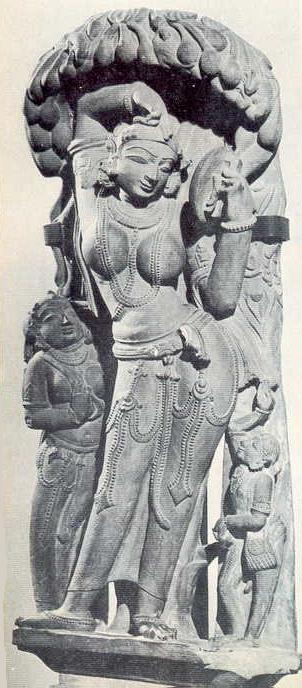
10th
century Nayika standing underneath a tree attended by her companions, while she
put the finishing touches to her toilet. In her left hand she holds a mirror,
while adjusting her coiffure with her right.
India's femininity and sexual ambiguity, is the very antithesis of Western
virility.
Prudery
was quite unknown to ancient Indian artists, who had no conception of ‘the
sins of the flesh’ with which Western civilization is so preoccupied
even today.
(image
source: India Ceylon Bhutan Nepal and the Maldives - By
The Illustrated Library of The World and Its Peoples - volume 2. p.
330).
***
According to
Guy
Sorman,
visiting scholar at Hoover Institution at Stanford and the leader of new
liberalism in France, writes: idea of feminism
and ecology came from the 1968 movement, from the meeting between India and the
West. He says: "There is hardly
anything in European thought to predispose the West to reject virility, the
respect for authority, the mastery over nature. India too has a
warrior (khastriya) tradition of virility as exemplified in the Mahabharata,
only it is secondary. First, comes the veneration of thousands of goddesses -
for the Indians, India is above all Mother India.
India's femininity and sexual ambiguity, is the very antithesis of Western
virility."
(source: The
Genius of India - By Guy Sorman ('Le Genie de
l'Inde') Macmillan India Ltd. 2001 p. 197).
The
Hindu Goddess became the subject of very serious and intense study by many white
women in the 1970s when they revolted against the male centric Abrahamic
religions. Today,
the Hindu Goddess is often used to enhance the historical narrative of Mother
Mary or to reinterpret European Goddesses such as Sophia, Diana, etc.
Furthermore, Gloria
Steinem,
one of the pioneers of the women's liberation movement in the US, spent two
years in India in the 1960s, and after her return to the US she helped to launch
the feminist movement. She
writes in her autobiography that it was her experiences with women's empowerment
groups in India that inspired her later work in the US.
Yet, Western scholars and
their Indian chelas have started to demonize the Hindu Goddess as vulgar, as a
symbol of sexual oppression of Hindu women, and as a cause of violence by upper
castes.
(source: Myth
of Hindu Sameness - By Rajiv Malhotra - sulekha.com). Watch the
movie
Agora
Testifying to the quiet continuance of an ancient tradition, Abanindranath
Tagore painted his famous watercolor Mother India in 1906, as a beautiful,
ascetic goddess clad in pale saffron. This dreamy image became the artistic icon
for the Indian nation during the struggle for independence. Bankim Chandra’s
unforgettable song Vande Mataram inspired countless patriots to their martyrdom
and still stirs, in everybody’s heart devotion to the motherland visualized as
Devi.
(source:
Devi
in Indian Arts -
By Utpal
K. Banerjee
Tour
India April 2001).
And more, an increasing number
of both theologians and lay-persons alike are beginning to see nature as being
distinctly feminine in essence – a fact that Sanatana Dharma and Yoga
philosophy has known and taught for over 5000 years. The Earth is not a static
dead rock floating in space that exists solely for man's economic purposes. The
Earth was not created by God to be partitioned into artificial geographic
regions, over which men will then foolishly war with one another. Rather, she is
a living being, a mother, a woman, a Goddess, whom we are to love, respect and
nurture - as she so patiently nurtures us. In the Hindu tradition, Mother Earth
even has a name: Bhu-devi. In Sanatana Dharma, the dual issues of respecting the
ways of nature and respecting women are ultimately inseparable concerns.
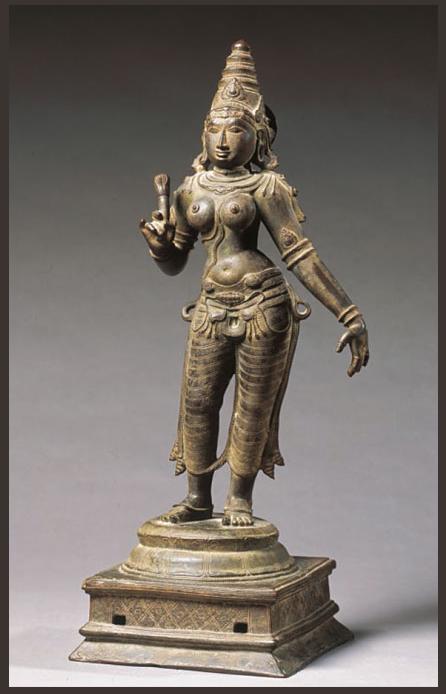
Goddess
Bhudevi, bronze - The consort of Lord Vishnu. She personifies the Earth.
To
worship the Goddess is to honor the Earth and all the creatures. In
the Vedic literatures mother Earth is personified as the Goddess Bhumi, or
Prithvi. She is the abundant mother who showers her mercy oh her children.
The
Earth was not created by God to be partitioned into artificial geographic
regions, over which men will then foolishly war with one another. Rather, she is
a living being, a mother, a woman, a Goddess, whom we are to love, respect and
nurture - as she so patiently nurtures us. In the Hindu tradition, Mother Earth
even has a name: Bhu-devi.
The
female aspect of the Creator has been excluded by a world that has focused
exclusively on the male dominated religions of Judaism, Christianity and Islam. Such respect for the feminine
has not been as readily visible in the history of the Western world,
unfortunately.
Refer to the chapter on Symbolism
in Hinduism.
***
Such respect for the feminine
has not been as readily visible in the history of the Western world,
unfortunately. The documented treatment of women in the Western religions has
been a truly horrendous record - to state the situation quite lightly. The
Abrahamic religions of Judaism, Christianity and Islam have not had anywhere
near the same abundant degree of women in leadership throughout their respective
histories. Indeed, in Abrahamic religious institutions, the norm historically
has been to actively and systematically bar women from any and all positions of
authority. To this day, for example, women are barred from the priesthood, and
any other important position of real authority, in the Roman Catholic Church.
There are no women priests, no women monsignors, no women bishops, no women
archbishops, no women cardinals, no women Popes. Thousands of wise and
independent women healers and herbalists were burnt at the stake by the church
during the post-Classical Dark Ages.
(source: Sanatana
Dharma as a Liberating Force for Women - By Frank Gaetano Morales
- sulekha.com).
For Treatment of Women in Abrahamic faith, refer to Women
in Christianity and Islam
and
Mormonism.
Refer to Women's
Inferior Status in the Bible. Also refer to Public
whipping of women in United Kingdom -
the
whipping of females was not abolished until 1817. Refer to Death
by Hadith- Banality of Islamic murder and refer to A
rebuttal to Abul Kasem - Women in Hinduism – By R Maliger.
Also refer to Refer
to Be
wary of English translations of Hindu scriptures - By Sheena Patel
 Recently
Chicago radio and TV talk-show, Tony Brown
has made remarks like "A
woman in the India is never free." (refer to Hindu-bashing
Chicago Radio and TV talk show airs).
Perhaps Mr. Brown should read 200 verses in the Bible that denigrate women Insults
to women in the Bible and Why
Women And The Bible Don’t Mix.
According to Ed Viswanathan author of Am I a Hindu?:
"It is pertinent to remember that St. Paul wrote in the Bible, women cannot be
leaders and cannot talk in church. That is why Catholics will never have a woman
priest. This country (USA) will take very many years for a woman or a black to
become president, where as India already had a women prime minister." St.
Paul says: “As
in all the churches of the saints, the women should keep silence in the
churches. For they are not permitted to speak, but should be subordinate, as
even the law says. If there is anything they desire to know, let them ask their
husbands at home. For it is shameful for a woman to speak in church.” [1
Corinthians 14:33-36]."
Refer
to Christianity
Versus Women By
Julia Hernandez and Al Seckel
- Martin
Luther
(1483
- 1546) wrote: "God created Adam Lord of all living
creatures, but Eve spoiled it all. Women should remain at home, sit still,
keep house and bear children. And if a woman grows weary and, at last,
dies from childbearing, it matters not. Let her die from bearing; she is
there to do it." [9, p. 923]. Recently
Chicago radio and TV talk-show, Tony Brown
has made remarks like "A
woman in the India is never free." (refer to Hindu-bashing
Chicago Radio and TV talk show airs).
Perhaps Mr. Brown should read 200 verses in the Bible that denigrate women Insults
to women in the Bible and Why
Women And The Bible Don’t Mix.
According to Ed Viswanathan author of Am I a Hindu?:
"It is pertinent to remember that St. Paul wrote in the Bible, women cannot be
leaders and cannot talk in church. That is why Catholics will never have a woman
priest. This country (USA) will take very many years for a woman or a black to
become president, where as India already had a women prime minister." St.
Paul says: “As
in all the churches of the saints, the women should keep silence in the
churches. For they are not permitted to speak, but should be subordinate, as
even the law says. If there is anything they desire to know, let them ask their
husbands at home. For it is shameful for a woman to speak in church.” [1
Corinthians 14:33-36]."
Refer
to Christianity
Versus Women By
Julia Hernandez and Al Seckel
- Martin
Luther
(1483
- 1546) wrote: "God created Adam Lord of all living
creatures, but Eve spoiled it all. Women should remain at home, sit still,
keep house and bear children. And if a woman grows weary and, at last,
dies from childbearing, it matters not. Let her die from bearing; she is
there to do it." [9, p. 923].
(source: India
Tribune - By Ed Viswanathan author of Am I a Hindu?). Refer
to Christian
Pastor had sex with daughters
- Sydney Morning Herald. Refer to Female
Victims of Clergy Abuse - Survivors
Network of those Abused by Priests.
Refer
to Christianity
and Women's Rights
and
Christianity
and its Persecution of supposed Witches
-
heretication.info).
Refer
to Amen
- an autobiography of a nun and
Mote
and the beam - By Sandhya Jain
Note:
The
Vatican
has ruled out all forms of feminist theology of the liturgy in
Catholicism, saying that God must always be recognised as "Our
Father". Feminist theology is a movement, generally in
Christianity to reconsider the traditions, practices,
scriptures, and theologies of their religion from a feminist
perspective. Reinterpretation of male-dominated imagery and language
about God is one of the important aspects of feminist theology. Pope
Benedict XVI, who wrote the latest ruling, has been a strong
opponent of feminism in the Catholic Church. From Day One of its
existence, Christianity was activated as a Patriarchal form of
Ideology. Patriarchy has been the bulwark of Christianity. It is a
legalized form of crime against Woman.
Refer
to Vatican-
Excommunication for female priests - The
Vatican
insisted Friday that it is properly following Christian tradition by
excluding females from the priesthood as it issued a new warning
that women taking part in ordinations will be excommunicated.
Refer
to Amen
- an autobiography of a nun and Mote
and the beam - By Sandhya Jain
(source: God
is Man Not Woman Reaffirms Vatican!
-
Deccan
Chronicle 5/17/08).
Watch
the movie - The
Magdalene Sisters (2002) treatment of "wayward women"
run by the by Catholic Church in Ireland in 1964.
 Elizabeth
Cady Stanton (1815-1902) American suffragist was tireless in her
criticism of the Bible, decrying their denigration of women. She wrote: Elizabeth
Cady Stanton (1815-1902) American suffragist was tireless in her
criticism of the Bible, decrying their denigration of women. She wrote:
"
I know of no other book that so fully teach the subjection and degradation of
women." (Women Without Superstition).
and
"The Bible and the Church have been the greatest stumbling blocks in the
way of women's emancipation." (Treasury of Women's
Quotations).
(source:
Famous
Dead Nontheists). Refer
to Love
& Sex in the Bible - History Channel (Part 3 of 5)
.
Refer to Examine
God's sexism
in the Bible - godisimaginary.com and to article on Iranian-born
founder Mina Ahadi.
Watch the
movie
Agora
 Annie
Besant
(1847-1933) British Theosophist. She was an active
socialist on the executive committee of the Fabian
Society along with George Bernard Shaw. George
Bernard Shaw regarded her the "greatest woman public speaker
of her time." Annie
Besant
(1847-1933) British Theosophist. She was an active
socialist on the executive committee of the Fabian
Society along with George Bernard Shaw. George
Bernard Shaw regarded her the "greatest woman public speaker
of her time."
She
was a prominent leader of India's
freedom movement, member of the Indian National
Congress, and of the
Theosophical Society. Dr. Annie Besant was a housewife, a propagator of atheism,
a trade unionist, a feminist leader and a Fabian Socialist.
She has observed:
“For centuries the leaders
of Christian thought spoke of women as a necessary evil, and the greatest saints
of the Church are those who despise women the most.”
(source:
What
Some Famous People Have Said About Christianity). For
Cruelty inflicted by Christianity - Watch Constantine's
Sword movie - By Oren Jacoby. Refer to Documentaries - The
Holy Inquisition – History Channel
and Secret
Files of the Inquisition – PBS. Watch video - Church's
Inquisition -Torturing Those Who Disagreed (1 of 6).
Refer to Love
& Sex in the Bible - History Channel (Part 3 of 5)
.
Refer
to Index
of Forbidden Books
and
Mexican
Inquisition.
Also refer to
Scandals in Church and
Amen
- an autobiography of a nun
Father Leo Booth
“There would be no need for the
women's movement if the church and Bible hadn't abused them.”
(source:
Things
that they don't tell you about Christianity). Refer to This
Church is a Cruel Joke - By George Augustine
Refer
to The
Status of Women in the Bible and early Christianity - religioustolerance.org
and Flagellation
of a Female Samboe Slave
in the USA.
Refer to Picture of slave 1806 by John Gabriel Stedman - britishlibrary.com
 Helen Ellerbe
a researcher, writer, and public speaker, has observed in her book, that: Helen Ellerbe
a researcher, writer, and public speaker, has observed in her book, that:
"Orthodox Christians
held women responsible for all sin. As the Bible Apocrypha states: "Of
woman came the beginning of sin/ And thanks to her, we all must die.' St.
Augustine, the much celebrated Father of the
Church, thought that sex was intrinsically
evil. Denying human free will and condemning sexual pleasure made it
easier to control and contain people. Christian
history is replete with condemnations of human sexuality. The witch hunts also
demonstrated great fear of female sexuality. The word “witch” comes from the
old English wicce and wicca, meaning the
male and female participants in the ancient pagan
tradition which holds masculine, feminine and earthly aspects of God
in great reverence. Hence, sexual desire was considered ungodly.
Christian philosopher, Boethius,
who wrote in The Consolation of Philosophy,
"Woman is a temple built upon a sewer." The 13th century St.
Thomas Aquinas suggested that God had made a mistake in creating
woman: Lutherans at Wittenberg debated whether women were really human beings at
all. Orthodox Christians held women responsible for all sin. As the Bible's
Apocrypha states: "Of woman came the beginning of sin/ And thanks to her,
we all must die." The witch hunts were an eruption of orthodox
Christianity's vilification of women, "the weaker vessel" in St.
Peter's words. The second century St Clement of
Alexandria wrote: "Every woman should be filled with shame by
the thought that she is a woman." And Lutherans at
Wittenberg debated whether woman were really human beings at all. Orthodox
Christians held women responsible for all sin. The Church father Tertullian
also explained why women deserve their status as despised and inferior human
beings." Pope John XXII formalized the persecution of witchcraft in
1320 when he authorized the Inquisition to prosecute sorcery." Witch hunt were justified
in those contexts with reference to the Bible's prescription: "Thou
shalt not suffer a witch to live." (Exodus 22:18). "The Burning
Times" is an English term referring to the time of the Great European
Witchhunts (1450-1750). Also sometimes referred to as Women's Holocaust. Refer
to Arthur Miller's play, The
Crucible. Refer to Women
- The Rise of the Religious Right in the Republican Party.
(source: The
Dark Side of Christian History - By Helen Ellerbe Morningstar
Books July 1995 ISBN 0964487349 p. 115 -
121). Also refer to Women:
China from Inside - pbs.org and Death
by Hadith- Banality of Islamic murder.
Refer to A
rebuttal to Abul Kasem - Women in Hinduism – By R Maliger. Refer
to Amen
- an autobiography of a nun and Mote
and the beam - By Sandhya Jain.
***
Francois
Gautier (1950 - ) Paris-born
has
lived in India for 30 years, is a political analyst for Le Figaro, one of
France's largest circulation newspaper.
He is the uthor of several
books, including
A Western journalist on India : The Ferengi's Columns
and
Rewriting Indian History and
A New History of India. He has remarked:

"Hindu have venerated the
feminine element under its different manifestations: Mahalaxmi, Mahakali,
Mahasaraswati, Maheshwari - and even India is feminine: "Mother India."
She is the consciousness transcending all things, she
is the emptiness beyond all emptiness, the smile beyond all smiles, the divine
beauty beyond all earthly beauties. "
(source:
A New History of India - By Francois Gautier
p. 1 - 18).
"Countries such as France or the United States, who are often preaching
India on "women's rights" never had a woman as their top leader
(President), whereas India had Indira Gandhi ruling with an iron hand for nearly
twenty years; and proportionately they have less MP's than India, which is
considering earmarking 33 % of seats in Parliament for women, a revolution in
human history!"
Thus in India - and it is true that it is often a paradox,
as women, because of later Muslim influences, have often been relegated to the
background - the feminine concept is a symbol of dynamic realization. She is the
eternal Mother, who is all Wisdom, all Compassion, all Force, Beauty and
Perfection. It is in this way that since the dawn of times, Hindus have
venerated the feminine element under its different manifestations. Mahalaxshmi,
Mahakali, Mahasaraswati, Maheshwari - and even India is feminine: "Mother
India."
(source: Arise
O' India - By Francois Gautier - Har Anand
publisher ISBN: 81-241-0518-9 p.11-13). For more on
Francois Gautier refer to chapter Quotes221_250).
Refer to the chapter on Symbolism
in Hinduism.
Top of Page
Veneration
of Women in Vedic India
Will Durant
(1885-1981) American historian says:
"Women
enjoyed far greater freedom in the Vedic period than in later India. She had
more to say in the choice of her mate than the forms of marriage might suggest.
She appeared freely at feasts and dances, and joined with men in religious
sacrifice. She could study, and like Gargi, engage in philosophical disputation.
If she was left a widow there were no restrictions upon her remarriage."
(source: Story
of Civilization: Our Oriental Heritage - By Will Durant
MJF Books.1935 p. 401). For more on Will Durant refer to chapter Quotes1_20
and Hindu Art).
Louis Jaccoliot
(1837-1890) who worked in French India as a government official
and was at one time President of the Court in Chandranagar,
translated numerous Vedic hymns and the celebrated author
of the Bible
in India: Hindoo Origin of Hebrew and Christian Revelation said:
"India of the Vedas entertained a respect
for women amounting to worship; a fact which we seem little to suspect in Europe
when we accuse the extreme East of having denied the dignity of woman, and of
having only made her an instrument of pleasure and of passive obedience."
He also said: "What! here is a civilization, which you cannot deny to be
older than your own, which places the woman on a level with the man and gives
her an equal place in the family and in society."
(source: India
And Her People - By Swami Abhedananda - p. 253).
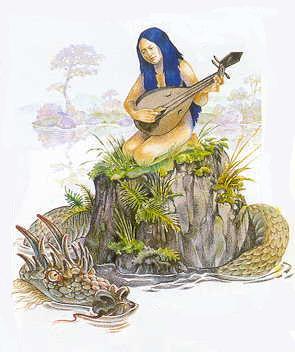
Goddess Saraswati known as Ben-ten in
Japan.
Goddess
Saraswati is the
embodiment of the mighty Saraswati
River of the Vedas.
For Japanese Saraswati, refer to chapter on Glimpses
XVII. Refer
to Women
in Vedic culture - By Stephen Knapp and chapter on Symbolism
in Hinduism.
***
In religious matters, Hindus have elevated women to the level
of divinity.
One of
the things most misconstrued about India and Hinduism is that it's a male-dominated
society and religion. It is not.
It is a culture whose only words for strength and power
are feminine -- "shakti'' means "power'' and "strength.'' All male power comes from the
feminine. The Trimurti (Brahma, Vishnu, Shiva) are all powerless without their
female counterparts.
Devi,
in the words of Romain Rolland, French Nobel
laureate, professor of the history of music at the Sorbonne and thinker, is the
Great Goddess, the invisible, the immanent, who gathers to her golden
arms the multiform, multicolored - Unity. This echoes the sixth century
Devi-Mahatraya prayer to her: By you this universe is borne, by you this world
is created. By you it is protected, O Devi: By you it is consumed at the end.
You are the Supreme Knowledge, as well as ignorance, intellect and
contemplation...
Indian Historian Romesh
C Dutt ( ? ) writes:
"Women were held in higher respect in India
than in other ancient countries, and the Epics and old literature of India
assign a higher position to them than the epics and literature of ancient
Greece. Hindu women enjoyed some rights of property from the Vedic Age, took a
share in social and religious rites, and were sometimes distinguished by their
learning. The absolute seclusion of women in India was unknown in ancient
times."
(source: The
Civilization of India - By R. C. Dutt p 21-22).
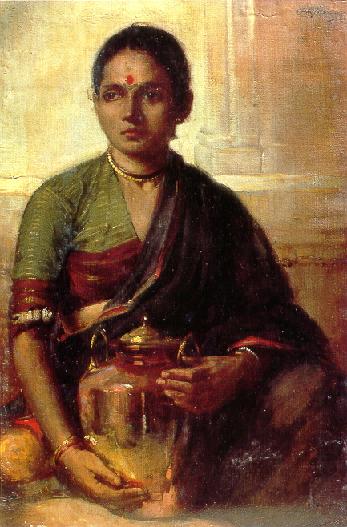
India of the Vedas entertained a respect
for women amounting to worship.
Refer to The
Sacred Feminine in Hinduism - By M L Goel and Women
in Vedic culture - By Stephen Knapp
and chapter on Symbolism
in Hinduism.
***
Women
and the Divine Word
"Profound
thought was the pillow of her couch,
Vision was the unguent for her eyes.
Her wealth was the earth and Heaven,
When Surya (the sun-like resplendent bride) went to meet her husband.
Her mind was the bridal chariot,
And sky was the canopy of that chariot.
Orbs of light were the two steers that pulled the chariot,
When Surya proceeded to her husband’s home!"
The
close connection of women with divine revelation in Hinduism may be judged from
the fact that of the 407 Sages associated with the revelation of Rig
Veda, 21
are
women.
***
Professor H. H. Wilson
( ? ) says: "And it may be confidently asserted that in no nation of antiquity
were women held in so much esteem as amongst the Hindus."
In Ancient India, however, they not only
possessed equality of opportunities with men, but enjoyed certain rights and
privileges not claimed by the male sex. The chivalrous treatment of women by
Hindus is well known to all who know anything of Hindu society.
"Strike not even
with a blossom a wife guilty of a hundred faults," says a Hindu sage,
"a sentiment so delicate," says Colonel James Tod "that Rignald-de-Born,
the prince of troubadors, never uttered any more refined."
(source: Hindu
Superiority - By Har Bilas Sarda Publisher: Scottish Mission
Industries. 1917 p. 93).
Louis Jaccoliot
(1837-1890) who worked in French India as a government official
and was at one time President of the Court in Chandranagar,
translated numerous Vedic hymns and the celebrated author
of the Bible
in India has observed:
 "Besides, what antiquity
wholly overlooked, but what we cannot too much admire in India, is its respect
for women, almost amounting to worship. "Besides, what antiquity
wholly overlooked, but what we cannot too much admire in India, is its respect
for women, almost amounting to worship.
This extract from Manu (shloka 55) will
not be read without surprise:
“Women should be nurtured
with every, tenderness and attention by their fathers, their brothers, their
husband, and their brother-in-law, if they desire great prosperity.”
“Where women live in
affliction, the family soon becomes extinct, but when they are loved and
respected, and cherished with tenderness, the family grows and prospers in all
circumstances.”
"This
veneration of women produced in India an epoch of adventurous chivalry during
which we find the heroes of Hindoo poems accomplishing high deeds, which reduce
all the exploits of Amadis, knights of the Round Table, and the Paladins of the
Middle Ages, to mere child’s play.”
(source: Bible
in India: Hindoo Origin of Hebrew and Christian Revelation - By Louis
Jacolliot p - 40-41 Panini
Office Bahadurganj. Allahabad 1916). For more on Louis Jacolliot refer to
chapter Qutoes61_80).
The history of the most of the
known civilizations show that the further back we go into antiquity, the more
unsatisfactory is found to be the general position of women. Hindu
civilization is unique in this respect, for here we find a surprising
exception to the general rule. The further back we go, the more satisfactory is
found to be the position of women in more spheres than one; and the field of
education is most noteworthy among them. There is ample and convincing evidence
to show that women were regarded as perfectly eligible for the privilege of
studying the Vedic literature and performing the sacrifices enjoined in it down
to about 200 B.C. This need not surprise us, for some
of the hymns of the Rig Veda are the compositions of rishnis or poetesses.
Some twenty different hymns were composed by poetesses. Visvara, Sikaata,
Nivavari, Ghosha, Romasa, Lopamudra, Apala and Urvasi are the names of some of
them. Man could perform the Vedic sacrifices only if he had his wife by his
side.
(source: Education
in Ancient India - By A. S. Altekar p. 207-209 Nand Kishore
& Bros. Varanasi.1965).
Knowledge,
intelligence, rhythm and harmony are all essential ingredients for any creative
activity. These aspects are personified in Saraswati, the Goddess of Learning,
Music and Fine Arts. Without the grace of Saraswati, or Saraswati-Kataksham,
as it is called, Brahma cannot do a worthwhile job as the Creator. Any
maintenance activity needs plenty of resources, mainly fiscal resources. So
Lakshmi, the Goddess of Wealth, is an essential companion to Vishnu.
Shiva,
as Destroyer, needs plenty of power and energy. This is what Parvati, or Durga
or Shakthi as she is called, provides. It is only the Hindu tradition,
which provides, even at the conceptual level, this picture of the male and
female principles working together, hand in hand, as equal partners in the
universe. This concept is carried further to its logical
climax in the form of Ardhanaareeswara,
formed by the fusion of Shiva and Shakthi in one body, each occupying one half
of the body, denoting that one is incomplete without the other.
Just
three shlokas which are commonly recited during daily prayers are enough
to show the status of the three Goddesses. A shloka on Saraswati contains
the following line: Yaa Brahma Achyuta Sankara Prabhrudibihi Devaissadaa
Poojithaa, which means, 'Saraswati who is always worshipped by Brahma,
Vishnu, Shiva and other Gods'.
And Shakti is the fundamental strength of the feminine that infuses all life and
is viewed as a goddess. Shakti is the divine feminine power found in everything.
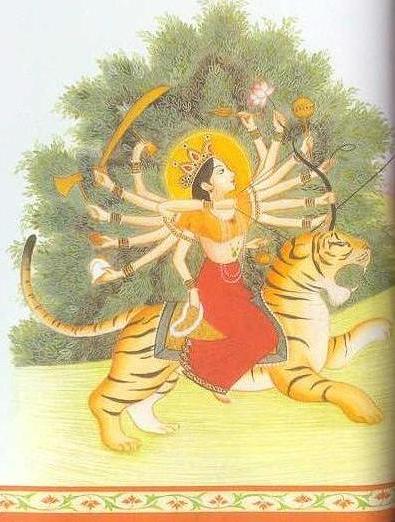 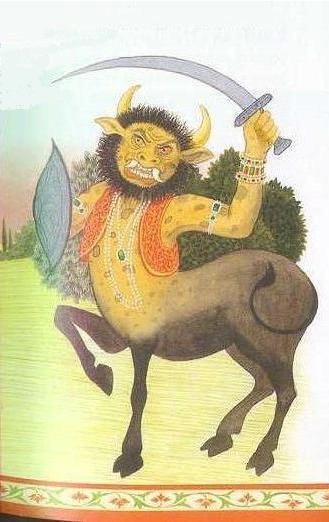
Goddess Durga and
Mahisha, the buffalo demon.
In Hinduism, all power, shakti, is female. Shakti is the fundamental strength of the feminine that infuses all life and
is viewed as a goddess. Shakti is the divine feminine power found in everything.
Refer to the
chapter on Symbolism
in Hinduism and
Women
in Vedic culture - By Stephen Knapp
***
In Hinduism, all power, shakti, is female. So, the
female represents the totality of the power, and the male is imaged as the agent
of the female. Also, in Hinduism, the sun is female and the moon is
male; he is born of her, dies into her, and is born of her again every month.
Shiva, this great power, is the moon god. Parvati, his consort, is the sun
power. And although the worship in the masculine-oriented action systems in
India is directly to Shiva, it's to the goddess Kali, that the worship finally
goes.
So that, actually, in India, Kali is the great divinity. .....the Hindu goddess Kali...is shown standing on
the prostrate form of the god Shiva, her spouse. She brandishes the sword of
death, i.e., spiritual discipline. The blood-dripping human head tells the
devotee that "he that loseth his life for her sake shall find it." The
gestures of "fear not" and "bestowing boon" teach that she
protects her children, that the pairs of opposites of the universal agony are
not what they seem, and that for one centered in eternity the phantasmagoria of
temporal "goods" and "evil" is but a reflex of the mind-as
the goddess, herself, though apparently trampling down the god, is actually his
blissful dream.
The Goddess
gives birth to forms
and kills forms.
 The Vedic pantheon includes a substantial number of
female goddesses. There are beautiful hymns to Usha, the dawn, imagined as an
alluring young woman: The Vedic pantheon includes a substantial number of
female goddesses. There are beautiful hymns to Usha, the dawn, imagined as an
alluring young woman:
Usha, the
dawn, is often invoked, and is the subject of some of the most beautiful hymns
that are to be found in the lyrical poetry of any ancient nation.
Beautous daughter of the sky!
Hold they ruddy light on high,
Grant us wealth and grant us day,
Bring us food and morning's ray.
White-robed goddess of the morning sky,
Bring us light, let night's deep shadows fly.
This light, most radiant of lights,
has come; this gracious one who illumines all things is born. As night is
removed by the rising sun, so is this the birthplace of the dawn....We behold
her, daughter of the sky, youthful, robed in white, driving forth the darkness.
Princess of limitless treasure, shine down upon us throughout the day." -
Rig Veda I. 113.
"We gaze upon her as she
comes
The shining daughter of the sky
The mighty darkness she uncovers,
And light she makes, the pleasant one that we see."
" Dawn on us with prosperity, O Usha, daughter of the sky,
Dawn with great glory, goodness, lady of the light, dawn thou with riches,
bounteous one....
O Usha, graciously answer our songs of praise with bounty and
with brilliant light.......grant us a dwelling wide and free from
foes..........."

Usha! (Dawn) Hail, Beautous daughter
of the sky!
(image source: The Splendour That Was
'Ind' - By K T Shah).
Refer to The
Sacred Feminine in Hinduism - By M L Goel. and chapter on Symbolism
in Hinduism.
***
Of
the hymns to other deities, the hymns to those to Usha, the Dawn, are especially
beautiful. Some of the loveliest nature poetry of this period is dedicated to
her, depicted as a young maiden who comes to mankind in the special
characteristics of the dawn. Dawn bring a feeling of hope and refreshment, of
entering into the activity of the universe.
Hindus
hold rivers in great reverence. The rivers are female
divinities, food and life bestowing mothers. As such, they are prominent among
the popular divinities represented in the works of art of the classical period. The
most holy of rivers, the best known and most honored, is the Ganga or Ganges.
She is personified as Goddess Ganga. The river rises from an ice bed, 13,800
feet above the sea level in the Garhwal Himalayas.
One of the most important of all Vedic hymns, the
so-called Devisukta, is addressed to Vak (speech, revelation), the goddess who
is described as the companion of all the other gods, as the instrument that
makes ritual efficacious: "I am the queen, the gatherer-up of
treasures..." It is not unimportant, that Earth (prithvi) is considered
female, the goddess who bears the mountains and who brings forth vegetation.
***
The
Union
of Man and Woman
She
is Language, he is Thought
She is Prudence, he is Law
He is Reason; she is Sense
She is Duty; he is Right
He is Will; she is Wish
He is Pity; she is Gift
He is Song; she is Note
She is Fuel; he is Fire
She is Glory; he is Sun
She is Motion; he is Wind
He is Owner; she is Wealth
He is
Battle
; she is Might
He is Lamp; she is Light
He is Day; she is Night
He is Justice; she is Pity
He is Channel; she is River
She is Beauty; he is Strength
She is Body; he is Soul
- The
Wisdom of The Vishnu Purana

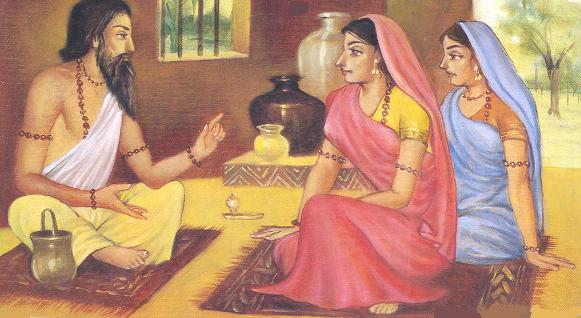
Gargi and Maitreyi
Women, who once
enjoyed an honored position and are found in the Upanishads
conversing freely with men upon the highest philosophical topics. Seventeen
of the seers to whom the hymns of the Rig
Veda were revealed were women — rishikas and
brahmavadinis.
Women were held in
higher respect in India than in other ancient countries, and the
Epics and old literature of India assign a higher position to them
than the epics and literature of ancient Greece.
Refer to The
Sacred Feminine in Hinduism - By M L Goel
***
Education for girls was
regarded as quite important. While Brahmin girls were taught Vedic wisdom, girls
of the Ksatriya community were taught the use of the bow and arrow. The Barhut
sculptures represent skilful horsewomen in the army. Patanjali mentions the
spearbearers (saktikis). Megasthenes speaks of Chandragupta's bodyguard of
Amazonian women. Kautilya mentions women archers (striganaih dhanvibhih). In
houses as well as in the forest Universities of India, boys and girls were
educated together. Atreyi studied under Valmiki along with Lava and Kusa, the
sons of Rama. Fine arts like music, dancing and painting was specially
encouraged in the case of girls.
Girls had upanayana performed for them and
carried out the sandhya rites. A young daughter who has observed
brahmacarya should be married to a bridegroom who is learned like her." (Yajur
Veda VIII.1).
Seclusion of women was unknown in the Vedic times.
Young girls led free lives and had a decisive voice in the selection of their
husbands. On festive occasions and at tournaments (samana) girls
appeared in all their gaiety. Women had a share in the property of the father,
and they were sometimes allowed to remain unmarried, with their parents and
brothers. The Atharva Veda refers to daughters remaining with their parents
until the end of their lives. A part of the ancestral property is given to them
as dowry, which becomes their own property, and is called stridhana
in later writings. "Home is not what is made of wood and stone; but where a
wife is, there is the home." (sanskrit: na grham kasthapasanair dayita
yatra tad grham - Nitimanjari, 68)
(source: Religion
and Society – By S. Radhakrishnan ASIN 8172231636 p. 140-149).
 It is significant to note that only Hindus worship God in the form of Divine Mother.
In Hinduism the deities for knowledge, learning and material wealth are female
and not male. The past social inconsistencies and injustices that did not arise
from Hindu scriptures, but from humans who failed to correctly incorporate the
teachings of the scriptures, such as the Upanishads and the Bhagavad Gita, into
their social philosophy. It is significant to note that only Hindus worship God in the form of Divine Mother.
In Hinduism the deities for knowledge, learning and material wealth are female
and not male. The past social inconsistencies and injustices that did not arise
from Hindu scriptures, but from humans who failed to correctly incorporate the
teachings of the scriptures, such as the Upanishads and the Bhagavad Gita, into
their social philosophy.
This concept of the spiritual equality of souls
naturally influenced the status of women on an individual and social level.
"Where women are honored there the gods are
pleased; but where they are not honored no sacred rite yields rewards,"
declares Manu Smriti (III.56)
a text on social conduct.
"Women
must be honored and adorned by their fathers,
brothers, husbands and
brothers-in-law, who desire their own
welfare." (Manu
Smriti III,
55)
"
Where the female relations live in grief,
the family soon wholly perishes; but
that family where they are not unhappy ever prospers." (Manu
Smriti III, 57).
"The
houses on which female relations, not
being duly honored, pronounce a curse, perish completely as if destroyed by magic." (Manu
Smriti III,
58)
"
Hence men who seek their own welfare, should
always honor women on holidays and festivals with gifts of ornaments, clothes, and dainty
food."
(Manu
Smriti III, 59)
In
an old Shakta hymn it is said - Striyah devah, Striyah
pranah "Women are Devas, women are life itself."
(source:
Bharata
Shakti - By Sir John Woodroffe p. 95).
"If
a husband dies, a wife may marry another husband.
"If
a husband deserts his wife, she may marry another." (Manu, chapter IX,
verse 77).
(source:
Hindu
Superiority - By Har Bilas Sarda p. 95).
In
the Vedas, she is invited into the family 'as a river enters the sea' and 'to
rule there along with her husband, as a queen, over the other members of the
family. (source: Atharva Veda xiv. i. 43-44).
Sir Monier Monier-Williams
(1860-1888) Indologist
and head of the Oxford's Boden Chair, wrote: "Indian wives often possess
greater influence than wives of Europeans." He is not a true Hindu who does
not regard a woman's body as sacred as the temple of God. He is an outcast who
touches a woman's body with irreverence, hatred or anger."
"A woman's body," says Manu the law
giver, "must not be struck hard, even with a
flower, because it is sacred."
It is for this reason that the Hindus do not allow capital punishment for women.
The idea of equality was most forcibly
expressed in the Rig Veda (Book 5, hymn 61.
verse 8). The commentator explains this passage thus: "The wife and
husband, being the equal halves of one substance, are equal in every respect;
therefore both should join and take equal parts in all work, religious and
secular." No other Scripture of the world have ever given to the woman such
equality with the man as the Vedas of the Hindus. The Old Testament, the
Zend-Avesta and others, have made woman the scapegoat for all the crimes
committed by man. The Old Testament, in describing the creation of woman and the
fall of man, has established the idea that woman was created for man's pleasure;
consequently her duty was to obey him implicitly. It makes her an instrument in
the hands of Satan for the temptation and fall of the holy man with whom she was
first enjoying the felicity of paradise.
In
the Vaishnava tradition, which is the most prevalent Hindu tradition today, God is
worshipped as ‘Vishnu’
(all
pervading) together
with ‘Shri’, who is also addressed variously as ‘Lakshmi’
(deity
of wealth, splendor, prosperity).
They incarnate together, and their incarnations, namely that of Rama and Sita
respectively, and so on, are also worshipped as a couple. Perhaps a good idea of
the simultaneous and equal reverence that Hindus have for the feminine and the
masculine aspects of Divinity may be gauged from the following quotation
–Sage
Parashar said:
“O
Maitreya! Always a companion of Vishnu and the Mother of this Universe,
Devi Lakshmi is eternal. Vishnu is omnipresent, so is She.
If She is speech, Vishnu is the object of description.
Vishnu is the Law, and She is the Policy.
Lord Vishnu is knowledge, she is intelligence.
He is Dharma, She is good karma.
If Vishnu is the Creator, She is the Creation (that abides eternally with Him).
He is the mountain, She is Earth.
He is the virtue of contentment, She is the every satisfying.
If Lord Vishnu is desire, She is the object of desire.
He is the sacred Vedic ritual, she is the priestly fee…”
It
is important to note that when God is worshipped as ‘Divine Couple’ by
Hindus, the name of the feminine typically precedes that of masculine. For
instance, we say that we are worshipping ‘Sita-Ram’, ‘Radhe-Shyam’,
‘Uma-Mahesh’ or ‘Shri Vishnu’ and so on.
 The 126th hymn of the first book of the Rig Veda
was revealed by a Hindu woman whose name was Romasha; the 179 hymn of the same
book was by Lopamudra, another inspired Hindu woman. There are a dozen name of
woman revealers of the Vedic wisdom, such as Visvavara, Shashvati, Gargi,
Maitreyi, Apala, Ghosha, and Aditi, who instructed Indra, one of the Devas, in
the higher knowledge of Brahman, the Universal Spirit. Everyone of them lived
the ideal life of spirituality, being untouched by the things of the world. They
are called in Sanskrit Brahmavadinis, the speakers and revealers of
Brahman. The 126th hymn of the first book of the Rig Veda
was revealed by a Hindu woman whose name was Romasha; the 179 hymn of the same
book was by Lopamudra, another inspired Hindu woman. There are a dozen name of
woman revealers of the Vedic wisdom, such as Visvavara, Shashvati, Gargi,
Maitreyi, Apala, Ghosha, and Aditi, who instructed Indra, one of the Devas, in
the higher knowledge of Brahman, the Universal Spirit. Everyone of them lived
the ideal life of spirituality, being untouched by the things of the world. They
are called in Sanskrit Brahmavadinis, the speakers and revealers of
Brahman.
When Sankaracharya, the great commentator of the
Vedanta, was discussing this philosophy with another philosopher, a Hindu lady,
well versed in all the Scriptures, was requested to act as umpire. It is the
special injuction of the Vedas that no married man shall perform any religious
rite, ceremony, or sacrifice without being joined in by his wife; the wife is
considered a partaker and partner in the spiritual life of her husband; she is
called, in Sanskrit, Sahadharmini, "spiritual helpmate." This idea is
very old, as old as the Hindu nation.
In the whole religious history of the world a
second Sita will not be found. Her life was unique. She is worshipped as an
Incarnation of God. India is the only country where prevails a belief that God
incarnates in the form of a woman as well as in that of a man. In the
Mahabharata we read the account of Sulabha, the great woman Yogi, who came to
the court of King Janaka and showed wonderful powers and wisdom, which she had
acquired through the practice of Yoga. This shows that women were allowed to
practice Yoga. As in religion, Hindu woman of ancient times enjoyed equal rights
and privileges with men, so in secular matters she had equal share and equal
power with them. From the Vedic age women in India have had the same right to
possess property as men; they could go to the courts of justice, plead their own
cases, and ask for the protection of the law. Those who have read the famous
Hindu drama called Shakuntala, know that Shakuntala pleaded her own case and
claimed her rights in the court of King Dushyanata. Similar instance are
mentioned in the 10th book of the Rig Veda. As early as 2000 B.C. Hindu women
were allowed to go to the battle fields to fight against enemies. Sarama, one of
the most powerful women of her day, was sent by her husband in search of
robbers. She discovered their hiding place and then destroyed them.
(source: India
And Her People - By Swami Abhedananda - p. 255 -267). Please refer to Women
In Hindu Dharma - A Tribute. A brief compilation done by Vishal
Agarwal for the Hindu Students Society of the University of Minnesota.
Women were honored in ancient India. That is why
when even today when Hindus refer to the avatar Rama and his wife Sita, as Sita-Ram
and Radha-Krishna.
Women must be honored and adorned by their father,
brothers, husbands, and brother-in-law who desire great good fortune. Where women, verily are honored, there the gods rejoice;
where, however, they are not honored, there all sacred rites prove fruitless.
Where the female relations live in grief -- that family
soon perishes completely; where, however, they do not suffer from any grievance
-- that family always prospers. ..
Her father protects her in childhood, her husband protects
her in youth, her sons protect her in old age. The father who does not give away his daughter in marriage
at the proper time is censurable; censurable is the husband who does not
approach his wife in due season; and after the husband is dead, the son, verily
is censurable, who does not protect his mother. Even against the slightest provocations should women be
particularly guarded; for unguarded they would bring grief to both the families.
Regarding this as the highest dharma of all four castes,
husbands, though weak, must strive to protect their wives. His own offspring, character, family, self, and dharma
does one protect when he protects his wife scrupulously. . . The husband should engage his wife in the collection and
expenditure of his wealth, in cleanliness, in dharma, in cooking food for the
family, and in looking after the necessities of the household. . . .
Women destined to bear children, enjoying great good
fortune, deserving of worship, the resplendent lights of homes on the one hand
and divinities of good luck who reside in the houses on the other -- between
these there is no difference whatsoever.
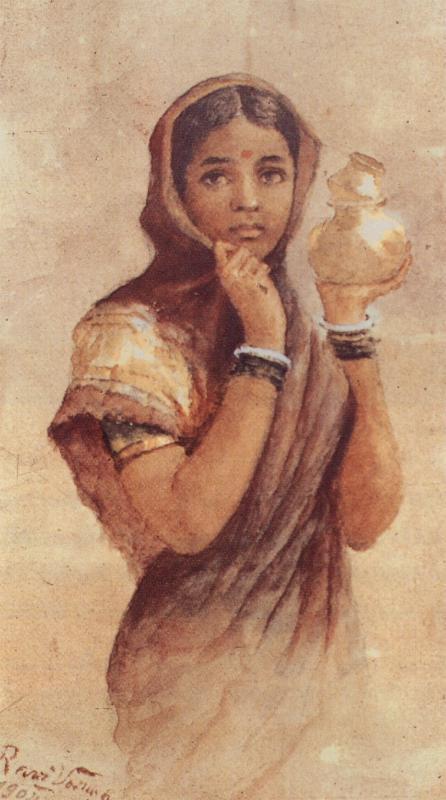
The Taittiriya Upanishad
teaches, "Matridevo bhava" - "Let your
mother be god to you."
Refer to the
chapters on Symbolism
in Hinduism and Hindu
Scriptures.
Refer
to Women
in Vedic culture - By Stephen Knapp
***
Motherhood is considered the greatest glory of
Hindu women. The Taittiriya Upanishad
teaches, "Matridevo bhava" - "Let your
mother be god to you."
Hindu tradition recognizes mother and motherhood
as even superior to heaven. The epic Mahabharata says,
"While a father is superior to ten Brahmin priests well-versed in the
Vedas, a mother is superior to ten such fathers, or the entire world."
Hinduism offers
some intriguing and unique examples of
strong women in the form of Goddesses. Two thousand years ago Saint
Tiruvalluvar observed: "What does a man lack if his wife is worthy? And
what does he possess if she is lacking worth?" There is more respect in the
East for women and for their role in society.
To instill such high ideals in humankind, Indian
ancestors created a plethora of goddesses who enjoyed equal status with their
husbands. The concept of Ardhanareeshwarar, where God is depicted as
half-man and half-woman, is a concrete example to support this argument. In many
philosophical texts God is referred to a Tat, meaning It and that
God is beyond gender. And, one would find a comparable Goddess for each God.
Further, we know for a fact that ancient India was permissive; women could have
multiple husbands, widows could remarry, divorce was permitted for incompatibility
or when estranged.
The article, Vedic Sociology by Dr.
B. G. Sudha in the Chinmaya Mission publication Our
Vedic Heritage throws considerable light on this aspect. To quote Dr. Sudha:
"There are a number of women who are
considered as the seers of mantras, like Saraswati, Goshaa, Vishvavaaraa,
Apaalaa, Urvashi, Indrani, and so on. It is said that Dhrutavati, the daughter
of Rishi Shandilya, spent her whole life in the study of the Vedas. Likewise,
another girl, Srutavati, the daughter of Sage Bharadvaja, also devoted her life
to the study of the Vedas.
The names of Gargi and Maitreyi are too well
known as great scholars of Vedic lore… We have statements like, "This
hymn must be recited by the wife,” in the Sroutasutras, which clearly
endorse the eligibility of women to the study of the Vedas. The Ramayana
describes the performance of Sandhya and Havana by Kausalya and Seetha. The wife
was a regular participant in the sacrificial offerings of the husband. (Rig
Veda I-122-2; 131-3; III-53-4-6; X-86-10 etc). Gobhila Gruhya Sutras state that the wife should be educated to be
able to take part in sacrifices. (Gobhila Gr. S. I-3)."
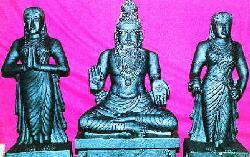
Yagnavalkya
with Gargi and Maitreyi
***
Woman
in the role of wife occupies a position of pre-eminence in ancient Hindu
tradition. The Hindus from the Vedic times believed in dual worship, Radha with
Lord Krishna and Sita with Lord Rama. In this dual worship, the names of Radha and Sita get precedence over the names
of their companions Krishna and Rama. This happens to be true of Goddess
Saraswati and her husband Lord Brahma. Lord Shiva appears united in a single
body with Shakti, his spouse; he at the right side and she at the left, in a
manifestation known as Ardhnarishwar, the half-man, half-woman
incarnation of God. Each
of the three principal Gods — Brahma the Creator, Vishnu the Protector and
Shiva the Destroyer — in the Hindu pantheon, is accompanied by a Shakti, which
is both his female double and his power of manifestation.
The Rig
Veda
too places woman on a high pedestal of sublimity: Yatr
nariyastu poojayante ramante tatr devah,
where woman is worshipped, Gods preside there.
Women, who once enjoyed an honored position and are
found in the Upanishads conversing freely with men upon the highest
philosophical topics,
had become virtual slaves in the joint family. With the expansion of Vedic religion in Northern India
and possibly also under the impacts of threats from the outside, a definition of
the place of women in the Aryan society took place, which amounted to increasing
restriction of their independence and a clear preponderance of patriarchal rule.
What has been described so far as "Vedic law for women" was largely
the tradition followed in North India, the Aryavarta, the Hindu heartland, South
India, and to some extent also Bengal and Assam, preserved elements of pre-Vedic
matriarchy. In certain South Indian castes the line of inheritance is from
mother to (eldest) daughter, and marriage is a "visiting"
relationship. Naturally, women were more independence and free in every
respect.
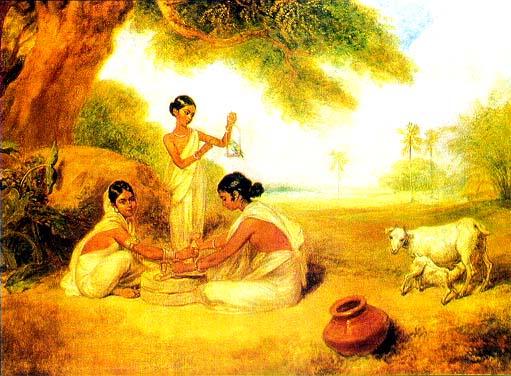 Ladies did not lead a secluded life like that of
their descendants in later times. Several hymns of the Rig Veda were composed by
female Rishis (sages). Young ladies of the time had a voice in their marriage.
"the woman who is of gentle birth and of graceful form," so runs a
verse in the Rig Veda, "selects among many of her loved one as her
husband." Numerous case of Svayamvara, that is, of ladies selecting
their own husbands, are mentioned in the Mahabharata and other works. There is
sufficient evidence to show, that widow marriage was
allowed, and that the right of Sati was unknown in the Vedic
period. Ladies did not lead a secluded life like that of
their descendants in later times. Several hymns of the Rig Veda were composed by
female Rishis (sages). Young ladies of the time had a voice in their marriage.
"the woman who is of gentle birth and of graceful form," so runs a
verse in the Rig Veda, "selects among many of her loved one as her
husband." Numerous case of Svayamvara, that is, of ladies selecting
their own husbands, are mentioned in the Mahabharata and other works. There is
sufficient evidence to show, that widow marriage was
allowed, and that the right of Sati was unknown in the Vedic
period.
"Rise up woman," so runs a text of the
Rig Veda (X, 18.8) "thou art lying by one whose life is gone, come to the
world of the living, away from thy husband, and become the wife of him who holds
thy hand and is willing to marry thee."
(source: Civilization
Through The Ages - By P. N. Bose p. 126-127).
Millions
of Hindu
women throng Kerala festival
“There
is nothing like this anywhere else in the world. It is amazing the way a whole
city makes arrangements for women to make this offering.”
-
Diane
Jennet, devotee
 India
's southern state of
Kerala may have hosted the largest gathering of women ever seen on the planet.
Clad in
traditional Kerala saris and bearing offerings of food, more than two million
women - perhaps more - thronged the state capital
Trivandrum
on Sunday. India
's southern state of
Kerala may have hosted the largest gathering of women ever seen on the planet.
Clad in
traditional Kerala saris and bearing offerings of food, more than two million
women - perhaps more - thronged the state capital
Trivandrum
on Sunday.
The women braved searing heat to offer a special meal at the Attukal
temple to Hindu Goddess Bhagavathy
- one incarnation of the potent goddesses Kali and Saraswati.
The
legend goes that Bhagavathy once visited the spot where the temple stands today
on the banks of the Killiyar river. The
goddess, in the guise of a girl, sought the help of the head of a local family
to cross the river. He helped her - but she vanished soon after.
In the
ancient religious texts, Bhagavathy is said to
annihilate evil and protects the good in this world - she grants every wish of
her devotees. This is also the fervent hope of the women who come year on year.
Guinness
Worlds Records certified the crowd strength was 1.5 million when it was assessed
for the first time in 1997. Last year turnout was 2.5 million and this year,
according to festival organisers, it was estimated to be 3 million. Attukal
Bhagavathy Temple Trust secretary KP Ramachandran Nair says that from next year
an agency associated with the National Geographic channel will conduct aerial
surveys for a more scientific headcount.
(source:
Millions
of women throng Kerala festival -
BBC news.com).
Similar views are
echoed by Radha Kumud Mukherjee
in his article Women In Ancient India
from the book Women
Of India (Publications Division, Ministry
of Information and Broadcasting, Government of India, New Delhi-110001, 1990).
He says:
"Every hymn of the
Rigveda is attributed to a
rishi. Though the
majority of these hymns were the work of male rishis, the Rigveda
contains hymns which were revealed by women seers also. The latter were called rishikas
and brahmavadinis...
"
The brahmavadinis
were products of educational discipline of
brahmacharya, for which women
were also eligible. The Rigveda (v, 7, 9) refers to young maidens
completing their education as
brahmacharinis
and then gaining husbands… Rig Veda. iii (55, 16) mentions unmarried learned and young daughters who should be
married to learned bridegrooms.
(For more on women's education refer to chapter on
Education
in Ancient India).
Sir John Woodroffe
aka
Arthur Avalon (1865-1936)
the well known scholar, Advocate-General of Bengal and sometime Legal Member of
the Government of India. He served with competence for eighteen years and in
1915 officiated as Chief Justice. has written:
"Woman was to the Hebrews an inferior being. As Elizabeth
Cady Stanton says in Woman’s
Bible “The canon and civil law, Church and State alike taught
that woman was made after man, of man and for man, an inferior being, subject to
man.”
St Paul and the Christian fathers
approved her inferiority and subjection. Their disdain for her and their
contempt for marriage are known. St. Augustine asks himself why She was created
at all. She is the “root of all evil” created from a rib of Adam’s body
not from a part of his soul.”
In the feudal legislation of Europe woman sank lower and
lower. As William
Edward Hartpole
Lecky says “woman sank to a lower legal position than she had
ever occupied under Paganism. Ernest Legouve
says (Histoire
Morale des Femmes p. 183) that “under the feudal regime
conjugal morals return to brutality.” Mrs. Cady Stanton gives a summary (History
of Women’s Suffrage iii, p. 290) of the English Common Law
which, basing itself on the alleged inferiority of woman, deprived her of the
control of her person and property and made her morally and economically
dependent on her husband.
"On the contrary many beautiful
sayings are found which give honor to woman, marriage, and motherhood, and Hindu
law recognizes her rights of property (Stridhan).
In the Shakta Tantra
in particular, woman is regarded as a Divinity, as the earthy representation of
the great Mother of all. Over and over again do they prescribe that no injury be
done her, that no ill-word even be spoken to her, but that she should be honored
always. The history of India tells of many women great in learning,
administration, and battle-prowress from Gargi, Maitreyi onwards, and there were
many more doubtless who are unknown to fame. "
(source:
Is
India Civilized - Essays on Indian Culture - By Sir John Woodroffe
Ganesh & Co. Publishers 1922 p. 195 - 202).
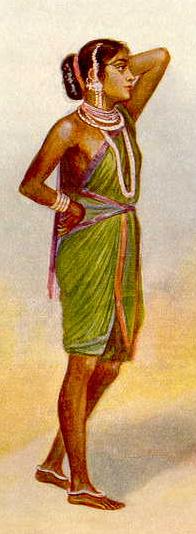
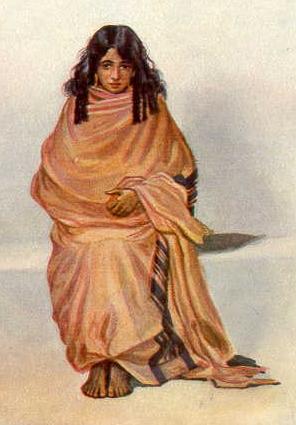 
Indian
Women - Paintings by Rao Bahadur M V Dhurandhar
(image source: The Splendour That Was
'Ind' - By K T Shah p. 25 - 29).
***
It is, therefore, no
wonder that the wife enjoyed with her husband full religious rights and
regularly participated in religious ceremonies with him. In fact, the
performance of such ceremonies would be invalid without the wife joining her
husband as his full partner… Some grammatical passages show that women had
other careers open to them apart from a mere literary career.
The great grammarian,
Patanjali,
author of that monumental masterpiece known as Mahabhashya,
uses the formation sakthiki to
indicate a female bearer of a spear [iv, 1, 15(6)]. In this connection, we are
reminded of the Amazonian bodyguard of armed women employed in his palace by the
Emperor Chandragupta Maurya, as described by Megasthenes, the Greek Ambassador
to his Court. Similarly,
Kautilya in his Arthasastra, which is also taken to be a document of
Mauryan history, refers to women soldiers armed with bows and arrows… Buddhism
kept up the traditions of Brahmanical religion in according to womanhood an
honoured place in social life. Women were made eligible for admission to what
was known as the Bhikshuni-Sangha, the Order of Nuns, which opened to
them avenues of culture and social service and ample opportunities for public
life.
(source: Women
in the Hindu Tradition By
S. G. V. Mani
http://www.sulekha.com/articledesc.asp?cid=111278).
In
Vedic times, Hinduism does not encourage homosexuality nor condemn it very
badly.
There
is no condemnation of homosexuality in Hindu scripture. Specific
mention is made in the Kama Sutra (4th century AD). Lesbians
are referred to as svarini,
women known for their independence, who refuse husbands and have relations in
their own homes
.
(source: Hinduism
- Lesbian/Gay switchboard. Note: During
the British Raj, homosexuality was considered a sin. The British passed the law
of 1860, which taken to be an improvement for Great Britain, which had
previously punished homosexuality by execution and torture, but
for India it was a great step backward since Hindu culture had never previously
criminalized homosexuality).
Padmini Sengupta
has written in her book, Everyday
Life in Ancient India:
 "The
position of women in ancient India was free and emancipated, and women were well
educated and respected members of society. A wife shared all her husband's
privileges and was his companion and help-mate in his activities."
The position of women was far better than in other countries of ancient times.
How else could it be in a culture which placed the Mother before the Father in
priority for reverence? Matr devo bhava
- was the first Upanisadic exhortation to the young. So far as we know, Hinduism
is the only religion whose symbolism places the Feminine on a par with the
Masculine in the profound concept of Siva-Sakti culminating in the image of
Ardharnari-Isvara. The Hindu has honored his country as his Motherland - Bharat
Mata and his nationalism has grown up from the seed Mantra - Vande Mataram. "The
position of women in ancient India was free and emancipated, and women were well
educated and respected members of society. A wife shared all her husband's
privileges and was his companion and help-mate in his activities."
The position of women was far better than in other countries of ancient times.
How else could it be in a culture which placed the Mother before the Father in
priority for reverence? Matr devo bhava
- was the first Upanisadic exhortation to the young. So far as we know, Hinduism
is the only religion whose symbolism places the Feminine on a par with the
Masculine in the profound concept of Siva-Sakti culminating in the image of
Ardharnari-Isvara. The Hindu has honored his country as his Motherland - Bharat
Mata and his nationalism has grown up from the seed Mantra - Vande Mataram.
(source: Hindu
Culture - By K. Guru Dutt (with a Foreword
by Sir C. P. Ramaswami Aiyar p. 241-242).
***
The Equals of Men
Seventeen of the seers to whom the hymns of the
Rig Veda were
revealed were women — rishikas
and brahmavadinis.
They were Romasa,
Lopamudra, Apata, Kadru, Vishvavara, Ghosha, Juhu, Vagambhrini, Paulomi, Jarita,
Shraddha-Kamayani, Urvashi, Sharnga, Yami, Indrani, Savitri and Devayani.
The Sama Veda mentions
another four: Nodha (or Purvarchchika),
Akrishtabhasha, Shikatanivavari (or Utararchchika) and Ganpayana.
There were shaktikis or
female spear bearers according to Patanjali's
Mahabhashya, and women
soldiers armed with bows and arrows in the Mauryan
army, according to Kautilya’s Arthashastra.
The Greek Ambassador Megasthenes
mentions Chandragupta Maurya’s armed female bodyguard. Thus education was not
the only vocation for women.
Islamic rule in North
India saw a sharp decline in the status of
women, now relegated to the veil, both as an influence of the new dispensation
as well as for their personal protection. Jauhar
protected Rajput women from captivity. If women
came out of the confines of the home, the new court culture made them either
entertainers or chattels, both highly degrading positions. Thousand years of the
purdah was to have a
highly detrimental effect on women, something from which the northern states
have yet to recover.
(source:
The
equals of men - By Nanditha Krishna - newindpress.com).
***
Anti-native reporting in media
and dowry deaths
Hey
Hinduism! You have made the life happy by projecting the woman as Goddess and
laying a fencing of chastity around her! I love you like my life!”
- Poet
Kannadasan in “Meaningful Hinduism” (Arthamulla Inthu Matham).
Koenraad Elst
(1959 - ) Dutch historian writes: "This anti-native and pro-westernizing bias is quite systematically
present in India reporting. It generally takes the form of gross
misrepresentation of Indian culture. For example, time and again those
correspondents write to the homefront that there are "still" many
dowry deaths. Now everybody knows that dowry deaths typically occur in the
westernized circles. (the dowries concerned are seldom the traditional jewels,
but mostly videomachines, fridge etc). they are not a traditional phenomenon
that "still" exists, but are a typical case of perverting and
poisoning of a native custom by the invasion of Western consumerism"
(source: Ayodhya
and After - By Koenraad Elst - Voice of India Issues Before Hindu
Society SKU: INBK2650 p. 82). Also refer to Women:
China from Inside - pbs.org.
Dowry-deaths
in India are of high interest in the West whereas
spousal-killings in America are not given the same emphasis, despite
that fact that statistically the percentage of American women victims of spousal
killings are at least as high as the percentage of Indian women victimized by
dowry-deaths. The language of 'dowry-deaths' is so India-specific, to begin
with, that it precludes the equivalent American phenomenon to be within range of
the radar. Once thus framed, the issue of dowry-deaths then gets measured,
studied at various levels of scholarship, and gets a life of its own. America's
equivalent problems get exempted from examination, especially as the scholars
place themselves on a platform above the glass ceiling.
(source:
Is
There an American Caste System? - Rajiv
Malhotra
-
sulekha.com). Refer
to Shunned
from society, widows flock to city to die
- By Arwa Damon - CNN - July 5 2007.
Conclusion
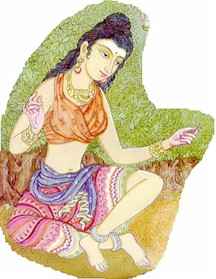 In ancient India, Hindu
women did not veil their faces and they enjoyed considerable amount of freedom
in society. But repeated attacks on Hindu India by foreigners through centuries
changed the situation. In ancient India, Hindu
women did not veil their faces and they enjoyed considerable amount of freedom
in society. But repeated attacks on Hindu India by foreigners through centuries
changed the situation.
(For more on
foreign invasions, please refer to chapter History
of Hinduism).
During such aggressions,
and also when India was under foreign occupation, the honor and chastity of
women often became the casualties. There have been numerous cases when Hindu
women killed themselves rather than yield to indignities inflicted by the
aggressors. As a result, Hindu society, became more protective about its women.
The freedom of women was curtailed. To protect themselves Hindu women started to
cover their faces with veils and started to stay home. Their participation in
social events was greatly restricted.
(source:
The
Essentials of Hinduism: A Comprehensive Overview of the
World's Oldest Religion - By Swami Bhaskarananda
p. 52-53).
"The killing of men
and enslaving of women and children was standard practice in Islamic conquests.
Thus when Mohammed bin Qasim conquered the lower Indus basin in AD 721, he
entered Multan and, according to the Chach-Nama, "6,000 warriors were put
to death, and all their relations and dependents were taken as slaves."
This
is why Rajput women took to immolating themselves en masse to save their honor
in the face of the imminent entry of victorious Muslim armies,
eg. 8,000 women immolated themselves during Akbar's capture of Chittorgarh in
1568 (whereas this most enlightend among Muslim rulers also killed 30,000 non-combattants).
(source:
The
Saffron Swastika - By Koenraad Elst
Voice of India ISBN 8185990697 p.
824).
Top of Page
Sati,
the much-highlighted face of Hinduism
excerpts
By Koenraad Elst
Secularist make the predictable allegation that Hinduism as
represented by Manu is anti-woman. Actually on reading this text one would
realize that neither dowry (dahe) nor self-immolation of widows (sati) figure in
it. Fredrick Nietzsche praised Manu’s
affection for woman.
Compare study of Indo-European cultures suggests that the
incidence of sati is inversely proportional to the status of women: from very
common among the Celts (“massively!”
says Bernard Sergent in his book - Les Indo-Europeens), where women were rather independent, to a mere epic
memory among the Greeks, where women were men’s property and not considered to
have much ‘honor’ to uphold by means of heroics.
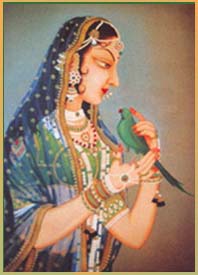 Ashish Nandy, an Indian
Christian, and author of the book Sati,
The Blessing and The Curse, recommends Ananda
Coomaraswamy spirited defence of sati: Ashish Nandy, an Indian
Christian, and author of the book Sati,
The Blessing and The Curse, recommends Ananda
Coomaraswamy spirited defence of sati:
“to shallow, pompous
progressives and feminists who believe that one ought only to immolate oneself
for secular causes like revolution and nationalism, not for old fashioned
religious or cultural causes.”
Nandy informs us: “The last “large-scale epidemic of
sati” (in Westernizing Bengal of the early 19th century, where new British
inheritance laws turned a surviving daughter-in-law into a pecuniary
rival) was a “logical culmination of rational, secular cost-calculation
against the background in traditional values….if anything, modern values, not
traditional ones, were to blame.” Indeed, “the epidemic was a feature of
exactly the part of the society – the Westernizing, culturally uprooted, urban
and semi-urban Indians – that was most dismissive towards the rest of society
as a bastion of superstition and activism.”
This is even more true of the dowry
murder plague, a typically modern, consumerist phenomenon, historically
unconnected to sati.
The Christian scholar, J. N.
Farquhar wrote in his book Modern
Religious Movements in 1914, that “the evil
seems to be largely a result of the progress of Western education.”
He adds an example of a girl in Calcutta who committed suicide “to release her
father from the impasse.” The first dowry deaths in the 19th
century were indeed suicides by daughters who tried to spare their fathers the
huge debts, and this was in the most anglicized communities.
However, the Indo- Anglican elite
has achieved complete success in passing on its self-interested version of the
facts to the outside world, as is evident in numerous anti-Hindu allegations
made in passing in articles…”
Ashish Nandy finds it “remarkable how, since the Deorala
event, there has been a revival of efforts by Anglophone, psychologically
uprooted Indians – exactly the sector that produced the last epidemic of sati
in eastern India – to vend sati as primarily a stigma of Hinduism, not as one
of the by-products of the entry of modern values in India.” The commotion
about the Deorala sati was just one expression of the colonial mind-set of the
ruling class: “At one time, most such efforts were closely associated with
attempts to justify the British rule in India. Now, as a cultural projection of
a new form of internal colonialism, these efforts are primarily
associated
with the rootless, Westernized Indian haute bourgeoisie who control the media,
either directly or through the state.”
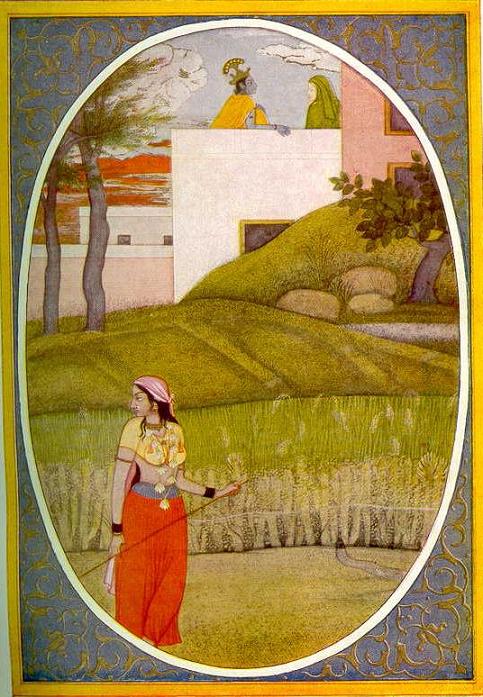
Village
beauty
(image
source: Studies in Indian
Painting - By N C Mehta).
***
The abysmally negative image which Hinduism has acquired has
a lot to do with Nandy’s following observation:
“Colonialism has to try to discredit the cultures of the
colonized to validate the colonial or quasi-colonial social relationships that
it itself has created.
Culture can be resistance, and those seeking hegemony in
the realm of political economy cannot afford to leave that area alone. The
self-declared social engineers in the Third World and their support base within
the tertiary sector of that world know this fully.”
No Hindu revivalist could have said it better. ...
(source:
Decolonising
The Hindu Mind - Ideological Development of Hindu Revivalism - By Koenraad
Elst Publisher: Rupa ISBN: 81-7167-519-0
p.513-518).
For more on Koenraad Elst refer to chapter Quotes201_220
and to
Universal
Rights and Cultural Relativism: Hinduism and Islam Deconstructed - By Catherine E. Polisi - Bologna Center Journal of International Affairs).
Also refer to Women:
China from Inside - pbs.org.

Asymmetric
depiction of Hinduism in US academia/texts books
Madhu
Kishwar (editor of Manushi, one
of India's foremost feminist journals) writes of the practice of widow
burning
“There
is absolutely no evidence that any of our vast array of religious texts
sanctified such murders as sati.”
(source: Deadly
Laws and Zealous Reformers: The Conflicting Interpretations and Politics of Sati
- By Madhu Kishwar,)
As Yvette Rosser
has said: Defining Hindu practices through a discussion of sati is no more
accurate than defining Christianity by delving at length into the "Burning
Times" in Medieval Europe when as many as nine million women, and even
children, were burned at the stake as witches through the encouragement and
official approval of the Christian Church. The burning of women does not define
Christianity any more than the burning of widows defines Hinduism – both are
long discarded practices of the past."
(source: The Clandestine
Curriculum in the Classroom -By Yvette C.
Rosser - Education About Asia, Vol. 6:3 (Winter 2001).
(source: Women
and Hinduism in U.S. Textbooks - by Dave Freedholm - sulekha.com).
Also refer to Women:
China from Inside - pbs.org.
Refer to Deepa
Mehta: Godmother of Anti Hinduism
- By Ron Banerjee - indiacause.com.
***
Self burning of widows was not
sanctioned by the Vedic religion, but was due to other causes. Some say that,
when the Mohmmadens conquered India, they treated the
widows of the soldiers so brutally that the women preferred death, and
voluntarily sought it. It is often said that the "Christian
government" has suppressed Suttee; but the truth is, that the initiatives
in this direction was taken by the noble Hindu, Rajah Ram Mohan Roy, who was,
however, obliged to secure the aid of the British Government in enforcing the
ideas, because India was a subject nation. The educated classed among the Hindus
had strongly protested against this inhuman custom, but as it could not be done
without the official help, appeal was made to the then Viceroy, Lord Bentincik,
a law against Suttee was passed.
Sir
Monier Monier-Williams (1860-1888) Indologist
and head of the Oxford's Boden Chair says:
 "Perhaps the most
important point to which Raja Ram Mohan Roy awakened was the
absence of all Vedic sanction for the self-immolation of widows
(Suttee). It was principally his vehement denunciation of this practice, and the
agitation against it set on foot by him, which ultimately led to the abolition
of Sati throughout British India in 1819." "Perhaps the most
important point to which Raja Ram Mohan Roy awakened was the
absence of all Vedic sanction for the self-immolation of widows
(Suttee). It was principally his vehement denunciation of this practice, and the
agitation against it set on foot by him, which ultimately led to the abolition
of Sati throughout British India in 1819."
(source: India
And Her People - By Swami Abhedananda - p. 280).
The
eighth richa (X 18.8) specifically commands a Hindu widow to return alive to her
home. H. H. Wilson translates: "Rise
woman, and go to the world of living beings; come, this man near whom you sleep
is lifeless; you have enjoyed this state of being the wife of your husband, the
suitor who took you by the hand." Here again, it is confirmed that X 18.8
actually commands a Hindu widow to return to the world of living beings. Also,
this very richa confers upon her full right on the house of her deceased husband
(apne putradi aur ghar).
Those who
misinterpret the Rigveda to say that it sanctions sati do this mischief by
misspelling the last word of richa X 18. 7 as "yomiagne." The last
word of this richa is actually "yomiagre." Thus, there is no richa in
Rigveda calling for widow burning. Veda,
Ramayana and Gita are the three supreme scriptures of Hindus.
All
others (like Brahmanas, Upanishads, Puranas, Dharmashastras, Sutras, etc. ) are
just commentaries, explanatory notes or stories written by individuals. As
commentaries written on the Constitution of India cannot override the articles
of the Constitution of India, similarly, commentaries or explanations on Vedas
by individuals cannot supersede richas of Vedas or the Ramayana or Gita. In the
Ramayana, everyone knows that after the death of King Dasharatha, his wives were
never asked to step into the pyre of Dasharatha. Rather, they lived in family
with full honour and Ram always bowed his head before his widowed mothers with
full respect. In the Mahabharata, Kunti, mother of the Pandavas did not commit
sati. Thus, there is no command in the Ramayana or in Gita to commit sati.
Over the
centuries, relatives have been murdering relatives for property. This will
continue in the coming centuries too. Greed is human nature. If
greedy people incite a widow to commit suicide on the pyre of her husband, let
us not say or believe that widow burning is sanctified by the Rigveda or by
Hinduism. Richa X 18.3 commands a Hindu widow to separate from the
dead and richa X 10.8 commands her to return alive to her children and her home.
For their own empowerment, Hindu women should to remember the seven richas viz
(II 17.7), (III 31.2) (X 18.3) (X l8.8) (X 40.2) and X 40.8) to assert and claim
their status and rights.
(source:
The Rigveda:
Widows don’t have to burn - By O. P. Gupta - The
Asian Age October 23, 2002 Mr. Gupta is ambassador of India to Finland).
Top of Page
Dowry
Murder: The Imperial Origins of a Cultural Crime -
How
British
colonialism created the economic and social climate in India that give rise to
various social ills.
James
Peggs (1739-1850) a man of cloth and a missionary, wrote:
"The doctrines of the
Hindoo religion have been singularly careful to protect the female sex and
infants from violence; and its is unlawful to put a woman to death for any
offense whatever...."Let all the four castes of Brahmin, Khetry (Khatri,
the diminutive of Kshatriya) Bys (Vaishya), and Sooder (Shudra), know that the
killing of a woman is the greatest of crimes."
Atrocity Literature and blaming Native Culture
Justification for Colonial Rule in India
 Rajiv
Malhotra ( ? )
founder of
The
Infinity Foundation, a non-profit organization in Princeton, New
Jersey and author of the book,
Breaking India: Western Inventions and Dalit Faultlines
has observed: Rajiv
Malhotra ( ? )
founder of
The
Infinity Foundation, a non-profit organization in Princeton, New
Jersey and author of the book,
Breaking India: Western Inventions and Dalit Faultlines
has observed:
"Atrocity literature played its part in downgrading women’s right, too.
Veena Oldenburg’s seminal book,
Dowry Murder, gives details on how the
British encouraged the Indians to dish out cases of atrocities that could then
be blamed on the native cultures. They
systematically compiled these anecdotes, mostly
unsubstantiated and often exaggerated and one-sided. This became a
justification to enact laws that downgraded the rights of common citizens. The
book shows how the dowry extortions that have become so common in middle-class
today, were actually started when women’s traditional property rights were taken
away by the British through convoluted logic."
(source:
Breaking India: Western Inventions and Dalit Faultlines -
By Rajiv Malhotra and Aravindan Neelakandan
p. 5). Refer to chapter on
European Imperialism
and
British aristocracy ‘ate human flesh’
***
The
Hindu custom of dowry has long been blamed for the murder of wives and female
infants in India. In this highly provocative book, Veena Oldenburg argues that
these killings are neither about dowry nor reflective of an Indian culture or
caste system that encourages violence against women. Rather, such killings can
be traced directly to the influences of the British colonial era.
In the Pre-Colonial
period, dowry was an institution managed by women, for women, to enable them to
establish their status and have recourse in an emergency.
As a
consequence of the massive economic and societal upheaval brought on by British
rule, women's entitlements to the precious resources obtained from land were
erased and their control of the system diminished, ultimately resulting in a
devaluing of their very lives.
Taking us on a journey into the
colonial Punjab, she skillfully follows the paper trail left by British
bureaucrats to indict them for interpreting these crimes against women as the
inherent defects of Hindu caste culture. The British,
publicized their "civilizing mission" and blamed the caste system in
order to cover up the devastation their own agrarian policies had wrought on the
Indian countryside.
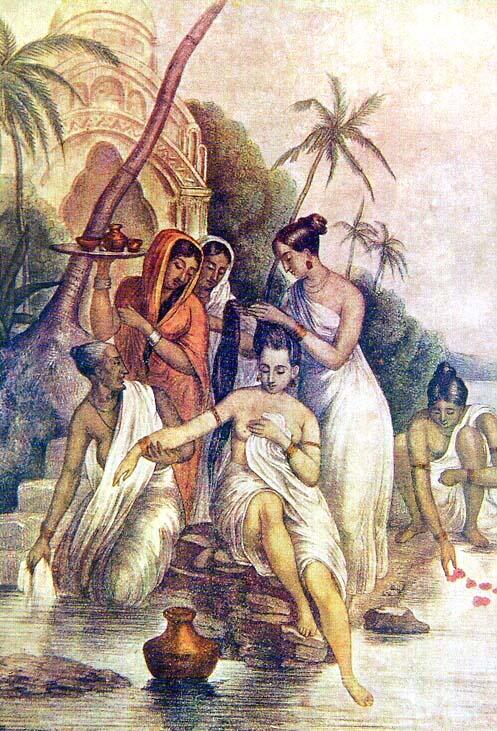
Ablutions of a young woman
The British,
publicized their "civilizing mission" and blamed the caste system in
order to cover up the devastation their own agrarian policies had wrought on the
Indian countryside.
***
An East India Company officer made the
earliest causal link between the dowry system and violence against girls in
1789, when he discovered female infanticide. The finding added powerfully to the
company’s description of the exotic “cruel” and “barbaric” culture
encountered in the process of its conquest of this strange land. On the backs of
such discoveries rode the moral imperative of imperialism – its famous
“civilizing mission.” This served as the most
compelling justification, both to the company itself and to a critical public in
England, for the conquest, pillage, and domination of Indian peoples and the
destruction of their local cultures. It was in this context too, that
Hindu women’s apparently degraded position in an allegedly rigid caste system
became a central preoccupation of colonial rulers and the subject of endless
debates, reform rhetoric, and legislation.
In 1813 the “civilizing mission” received an additional fillip when the
British Parliament passed the India Act of 1813 to admit missionaries, who had
hitherto been excluded from tinkering with the most exquisite brand of
heathenism in the wild Indian empire because of their politically volatile
denunciation of Hindu beliefs and practices. Christian missionaries added
greatly to the self-righteousness bombast of this mission. James
Peggs, a man of the cloth, made an exhaustive, lurid,
and cliche-laden compendium on the entire gamut of "Hindoo
social evils." His text was cobbled from pertinent Parliament Papers and it
first appeared in 1826 as Suttee Cry to Britain, followed by a thicker version
with female infanticide added on and tellingly called India's
Cries to British Humanity. In 1832 this pamphlet was fattened
from 110 pages to 518, and renamed Cries of Agony: An Historical Account of
Suttee, Infanticide, Ghat Murders, and Slavery in India. The Coventry School for
the Abolition of Human Sacrifice in India published an abridgement of the
original pamphlet and distributed free copies. It remains in print to this day!
It was a great victory for William
Wilberforce and fellow Evangelicals in England to expand their
operations to the Indian theatre. The prime target for reform was the generally
hapless "Hindoo woman."
These
masterly representation of a distant and dangerous world plagued with "Hindoo
barbarities, as they were increasingly called (despite
the failure to find them sanctioned in any "Hindoo" texts)
rendered India the ideal site for continued and expanding colonial control.
(source: Dowry
Murder: The Imperial Origins of a Cultural Crime - By Veena Talwar Oldenburg
42 - 46. For more refer to
chapter on European
Imperialism).
(Note:
During
the British Raj, homosexuality was considered a sin. The British
passed the law of 1860 - Section 377 of the
Indian Penal Code, which taken to be an improvement for Great Britain, which had
previously punished homosexuality by execution and torture, but
for India it was a great step backward since Hindu culture had never previously
criminalized homosexuality. For more refer to chapter on thoughts).
***
Dowry
And Dowry Demands: What's And How's - By Beloo Mehra
For a while, we
also goofed around with the idea of doing what the African-American feminist
author
Bell Hooks
refers to as an
“oppositional gaze"
by coming up with
suggestions for 'informative' documentaries that Indian cable TV networks could
produce on the various societal problems in the west.
One member wrote:
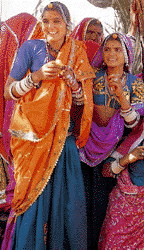 “Why peep into
other people's lives when your own is an unmitigated mess? Is it because you
feel that you can get away with it because no one will be peeping into your own
house? In my opinion, there is something indecent about 60 minutes poking their
nose into someone else's business when they should have been more concerned
about the 100 or more date rapes that would have happened just over the duration
of this one single show.” “Why peep into
other people's lives when your own is an unmitigated mess? Is it because you
feel that you can get away with it because no one will be peeping into your own
house? In my opinion, there is something indecent about 60 minutes poking their
nose into someone else's business when they should have been more concerned
about the 100 or more date rapes that would have happened just over the duration
of this one single show.”
One
member suggested that such “internationalization of internal debates is highly
uni-dimensional and is equal to pathologizing India.”
As horrible as a
dowry-related crime is, it is no different from any other domestic violence
against women, which is a universal social problem. So, while I do not deny the
existence of dowry-related crime, I argue that a whole body of academic
literature focusing on studying this problem in isolation from the issue of the
universal problem of domestic violence has a very high potential of making it a
problem closely linked with Indian culture, which is not only bad scholarship
but also very dangerous. One
possible rationale for organizing such “international” conferences and
producing such journalistic reports like the one on CBS (For
Love Of Money -
By Christiane Amanpour) could be
that, by focusing on issues such as violence against "third world
women", the western media outlets and these academics help push the issue
of violence against women in the west in the background.
This only makes the situation worse for victims of violence in their own
countries.
In her book Dislocating
Cultures,
Uma
Narayan
writes:
"Most
Americans that I have talked to about dowry-murder know that many US
women are killed by their partners as a result of domestic violence.
Given that many members of the US public know
that domestic violence has fatal forms, why is it that they make no connection
between the "foreign" phenomenon of dowry-murder and the
"familiar" phenomenon of domestic violence?
A
friend who participated in my search for the numbers of US women annually killed
by their partners commented that she was surprised at the difference between the
"disappearing dead women" in US accounts of domestic violence and the
"spectacular visibility" of women murdered over dowry in India"
(p. 89).
Gandhiji,
Vivekananda etc. reacted sharply against external criticism but both stood
firmly for internal change.”
(source:
Dowry
And Dowry Demands: What's And How's - By Beloo Mehra -
sulekha.com). Refer to Deepa
Mehta: Godmother of Anti Hinduism
- By Ron Banerjee - indiacause.com.
Top of Page
Christian
Missionary denigration of Indian Spiritual Dance
Attacking Devadasi Tradition in
Colonial India
From the 17th
century onwards, Christian missionaries made scathing
attacks on the Indian classical dance form seeing it as a heathen
practice. This was often expressed by attacking the
devadasi system on the grounds of human rights.
(Note:
Atrocity literature is a technical term referring to literature generated by
Western interests with the explicit goal to show that the target non-Western
culture is committing atrocities on its own people, and hence in need of Western
intervention and justify colonialism and Imperialism).
The devadasis were
temple dancers, dedicated in childhood to a particular deity. The system was at
its peak in the 10th and 11th centuries, but a few hundred years later, the
traditional system of temples protected by powerful kings had faded away under
Mughal rule especially since the Mughals turned it into popular entertainment
devoid of spirituality. The devadasi system degenerated
in some cases into temple dancers used for prostitution, although the extent of
this was exaggerated by the colonialists.
Many of the English educated elites of India accepted
the colonial condemnation of their heritage and apologized for its
"primitiveness." Some of them turned into Hindu reformers, and found
the devadasi system detestable for moral and even social-hygienic reasons.
However the devadasis saw their very existence threatened and sent handwritten
pleas to the colonial government explaining the spiritual foundation of Bharatha
Natyam. They quoted Siva from the Saiva Agamas
saying, “To please me during my puja, arrangements must be made daily for shudda
nritta (dance). This should be danced by females born of such families and the
five acharyas should form the accompaniments.” Since these Agamas are revered by
every Hindu, the devadasis asked, “What reason can there be for our community
not to thrive and exist as necessary adjuncts of temple service?” They opposed
the proposed draconian punishment for performing their tradition, calling the
legislation "unparalleled in the civilized world.”
Instead of
abolition of their traditional profession, they demanded better education to
restore their historical status. They wanted the religious, literary and
artistic education as in the past, saying, "Instill into us the Gita and the
beauty of the Ramayana and explain to us the Agamas and the rites of worship.”
This would inspire devadasi girls to model themselves after female saints like
Maitreyi, Gargi and Manimekalai and the women singers of the Vedas, such that,
“we might once
again become the preachers of morality and religion... You who boast of your
tender love for small communities, we pray that you may allow us to live and
work out our salvation and manifest ourselves in jnana and bhakti and keep
alight the torch of India's religion amidst the fogs and storms of increasing
materialism and interpret the message of India to the world."
Despite such
attempts, the missionary influence continued to dominate Bharata Natyam came to
be seen as immoral and facing almost certain extinction. For example, a
Dravidianist supported by missionary scholarship called the dance "the lifeline
that encourages the growth of prostitution."
However, Hindu savants worked tirelessly to remove the Christian slurs cast on
this art form.
 Chief
among them was Rukmini Devi Arundale
(1904-1986) who protected and revived this dance by founding the
Kalakshetra Academy of Dance and Music in
1936. She made it an acceptable norm for girls (and even boys) from middle class
households to learn Bharat Natyam. Though operated like a modern institution, it
functioned as a traditional gurukula with prayers before the deity Ganapati,
vegetarianism, and a guru-shishya relationship. Throughout Tamil Nadu the guru-shishya
form of decentralized one-on-one learning spread in various ways as part of this
revival. Thus, far from being dead as intended by missionaries, colonialists and
their Indian cronies, Bharat Natyam again became well established as a spiritual
art form in South India, and started to achieve acclaim throughout India and
abroad. Kalakshetra grew into a university with a large campus in Chennai. Chief
among them was Rukmini Devi Arundale
(1904-1986) who protected and revived this dance by founding the
Kalakshetra Academy of Dance and Music in
1936. She made it an acceptable norm for girls (and even boys) from middle class
households to learn Bharat Natyam. Though operated like a modern institution, it
functioned as a traditional gurukula with prayers before the deity Ganapati,
vegetarianism, and a guru-shishya relationship. Throughout Tamil Nadu the guru-shishya
form of decentralized one-on-one learning spread in various ways as part of this
revival. Thus, far from being dead as intended by missionaries, colonialists and
their Indian cronies, Bharat Natyam again became well established as a spiritual
art form in South India, and started to achieve acclaim throughout India and
abroad. Kalakshetra grew into a university with a large campus in Chennai.
Strategic
Shift: Subtle Christian Appropriation of Hindu Dance
In recent
years, missionaries are again targeting Bharat Natyam. But this time as a
takeover candidate for digestion into Christianity. This reversal of strategy is
in response to the growing enthusiasm for Bharat Natyam, including among many
Western feminists who see Indian dance as a valorization of feminine sexuality.
Westerners took up this dance initially showing respect for Hindu practices and
symbols, and studied under Hindu gurus who naively welcomed the Christian
disciples. Each of the individuals who are at the forefront of
Christianizing the Bharata Natyam today was
initially taught by Hindu gurus. In India there are
many unsuspecting, or perhaps opportunistic, Hindu gurus who take this genre of
Christian students under their wings. These Christian disciples
worked very hard and many became exemplars, dancing to Hindu themes and
enthralling the media and audiences.
However, they
ran into conflicts between traditional Hindu art and Christian aesthetics and
dogma.
Father Francis Barboza,
a prominent Roman Catholic priest and dancer of Hindu art forms, confesses that
"the main difficulty I faced in the area of technique" concerned what is Indian
classical dance's unique feature, namely, the hand gestures (hasta) and
postures. Dr. Barboza has Christianized the Bharatha Natyam by inventing the
following Christian Mudras: God the Father; Son of God; The Holy Spirit; The
Risen Christ; Mother Mary; The Cross; Madonna; The Church; and The Word of God,
as well as two postures, Crucifixion and The Risen Christ.
This strategy is strikingly similar to the development of “Christian
Yoga” and “Jewish Yoga” by western practitioners
who take what they want from yoga but reject or replace any symbols or concepts
that are too explicitly Hindu.
Another example
is the Kalai Kaveri College of Fine Arts,
founded by a Catholic priest in 1977 as a cultural mission. He received
patronage from various sources and sent out priests and nuns to learn from
unsuspecting Hindu gurus. The college claims to be offering “the world’s first,
off-campus degree program in Bharathanatyam,” with another program in South
Indian classical music (both vocal and instrumental). Its website's home page
shows Dr. Barboza’s “Christian mudras” using the Christian "Father Deity" as the
Bharata Natyam mudra replacing thousands of years of Hindu mudras. Kalai Kaveri
is backed and funded as a major church campaign. The Tamil Nadu government is
also actively funding and promoting it.
Kalai Kaveri website states
respect for the
Vedic tradition:
“Music and dance when viewed in Indian tradition are fundamentally one spiritual
art, an integral yoga and a science of harmony. According to the Vedas, the
Divine Mother Vak (Vag Devi) sang the whole creation into being. God's eternal
life-force, Para Sakthi, entered or rather assumed the perennial causal sound
Nada through the monosyllabic seed-sound Om (Pranava). Thereby the phenomenal
world with its multiple forms evolved. This process of physical, vital, mental
and soul contact or holy communion with God aims at complete harmony, perfect
integration, and absolute identification with God, in all His manifested as well
as unmanifested Lila (divine play and dance) at the individual, cosmic and
supra-cosmic levels of existence.”
Blatantly
Rejecting Hinduism while Christianizing the Bharat Natyam
Rani David, the founder of
Kalairani Natya Saalai
in Maryland, USA, (strategically located right next to a prominent
Hindu temple) is even more blatant about Christianizing the Bharata Natyam. Her
website does not hesitate to reveal her disdain of Hindu symbols that are a part
of Bharatha Natyam, and her vow to remove them from the dance. She wants to make
Bharat Natyam non-Hindu. Rani David is also proud of her collaborations with
Father Barboza and other Indian Christians.
(source:
Breaking India: Western Inventions and Dalit Faultlines -
By Rajiv Malhotra and Aravindan Neelakandan
p. 88 - 124).
Top of Page
Women
as Purohita - priests
The concept of a female priest is not a new one.
Nutan Vimal Motilal is also a practising priest
and points out that women priests were written about in the sacred Vedic texts.
Hindu temples have also
requisitioned women.
"They were more honest, sincere and the
clarity with which they performed the ceremony was also refreshing," he
says.
 Both Sunitee Gadgil, who has
been practising for 10 years, and Nutan Vimal Motilal, who has been practising
for two, say they have never had a negative experience. Both Sunitee Gadgil, who has
been practising for 10 years, and Nutan Vimal Motilal, who has been practising
for two, say they have never had a negative experience.
With an increasing number of men of religion
taking up other more lucrative vocations, women are now stepping into the gap to
actually outnumber male priests in Maharashtra.
Dr. V L. Manjul, a research scholar and chief
librarian at Pune's Bhandarkar Oriental Re. search Institute, says "between
1986 and '96, about 6,000 women have been trained as purohits (priests) and
today, lady purohits outnumber male ones."
In the Vedic period, says
Dr. Manjul, "we come across female scholars like
Ghosha, Lopamudra, Romasha and Indrani. In the Upanishadic period, names of
women philosophers like Sulabha, Maitreyi, Gargi are encountered."
This
tradition is exemplified in a verse from "Bhihadaranyakopanishad,"
which reads "atha ya icched duhita me pandita jayeta," (a well-to-do
Political instability and successive foreign invasions further made it difficult
for women to take up formal learning, which made it impossible for her to
undertake Vedic studies and conduct Vedic rites.
(source:
BBC - April 26 '2001 and The Hindu February 5 1997).
Refer to Vatican-
Excommunication for female priests - The
Vatican
insisted Friday that it is properly following Christian tradition by excluding
females from the priesthood as it issued a new warning that women taking part in
ordinations will be excommunicated.
Top of Page
Famous Women of Ancient and Modern India
1. Gargi
 Gargi,
the wise and learned daughter of Rishi (sage) Vachaknu, was known
as Brahmavadini because of her having the knowledge of Brahma-vidya.
She participated in a debate with the knower of Brahma, Yajnavalkya in
the Yajnasala ( place for sacrifices ) of King Janaka. We get in
the Brhadaranyaka Upanisad a dialogue between Gargi and Yajnavalkya.
Thus it is evident that in ancient India, women used to obtain knowledge of many
sciences and disciplines. They also used to participate in public functions and
take part in intellectual debates. There used to be no ban of any sort in the
field of knowledge, this is established very clearly from the account of Gargi's
life. Gargi,
the wise and learned daughter of Rishi (sage) Vachaknu, was known
as Brahmavadini because of her having the knowledge of Brahma-vidya.
She participated in a debate with the knower of Brahma, Yajnavalkya in
the Yajnasala ( place for sacrifices ) of King Janaka. We get in
the Brhadaranyaka Upanisad a dialogue between Gargi and Yajnavalkya.
Thus it is evident that in ancient India, women used to obtain knowledge of many
sciences and disciplines. They also used to participate in public functions and
take part in intellectual debates. There used to be no ban of any sort in the
field of knowledge, this is established very clearly from the account of Gargi's
life.
A wife of Yajnavalkya, plays a major role in a section of the Brhadaranyaka
Upanishad, is the first Indian woman philosopher. One of the most
interesting discussions of this absolute principle is given in the form of a
dialogue between Gargi, and her husband Yajnavalkya, a great sage. Although in
the preceding dialogues Gargi has been warned not to ask too many questions,
lest her head fall off, she persisted, and was rewarded with answers to her
questions.
Yajnavalkya said: "Ask, Gargi"
She said: "That, O Yajnakvalkya, which is above
the sky, that which is beneath the earth, that which is between these two, sky
and earth, that which people call the past and the present and the future -
across what is that woven, warp and woof?"
Top of Page
2. Sita
Sita in the Valmiki Ramayana is not exactly
representative for Vedic stridaharma.
 To begin with, she chooses her own
husband in a competitive svayamvara, only the strongest and the smartest
prince will do. To begin with, she chooses her own
husband in a competitive svayamvara, only the strongest and the smartest
prince will do.
Again, after Kaikeyi's intervention, when Rama goes into forest
exile, she insists on accompanying him. Sita's strength and self-possession are
apparent. She is dutiful, indeed, but she has to argue her case in order to do
what she knows is right. She is not an obedient servant to a
godlike husband; she has a will of her own and her relationship to Rama is
governed by love for him, rather than obedience to his orders.
She shows her
determination and independence throughout the years in the forest; her
insistences that Rama get the gold-spotted deer and her command that Laksmana
come to his rescue, eventually leads to her abduction by Ravana. She shows
self-control and she doesn't give in to Ravanna's will. On being freed, she
defends herself whole-heartedly against Rama's accusations. She is far from
passive. It is in the
context of this "dwelling in another man's house" that Vedic
regulations for women are invoked and popular sentiment demands an ordeal to
prove her purity.
This strength of character has not gone unnoticed by
Indian women, who have found much in her to applaud. Despite being commonly held
up as a paragon of the submissiveness, obedience, and loyalty that many men
would like to see in their wives, women have often taken other lessons from her
behavior. To many Hindu women, she is a great heroine, not just a goddess.
Sita
is a unique ideal of fidelity and chastity. She had to undergo unbearable trial
and tribulations throughout her life but with the power of her unshakable
fidelity and dedication to her husband she bore all the difficulties of life
with fortitude and she, along with her husband, smilingly enjoyed the hardships
of life in jungle. The rakshas king Ravana failed to lower her
morale or weaken her moral strength.
 It was through the ordeal of fire that Sita
proved and established her virtue and stainlessness of her character. With
the injury of the time of exile ( Vanavasa ) when Sri Rama as the
king, in order to satisfy some of his subjects, banished Sita, she remained in
the hermitage of Rishi Valmiki. It was through the ordeal of fire that Sita
proved and established her virtue and stainlessness of her character. With
the injury of the time of exile ( Vanavasa ) when Sri Rama as the
king, in order to satisfy some of his subjects, banished Sita, she remained in
the hermitage of Rishi Valmiki.
The very fact that Rama and Sita are always mentioned
in one breath endows Sita with equality: whatever status Rama occupies, this
will also be Sita's. If he is king, she will be queen, if he is god, she will
become his goddess. However, she is queen and goddess on her own merit, not
because of Rama's grace.
Top of Page

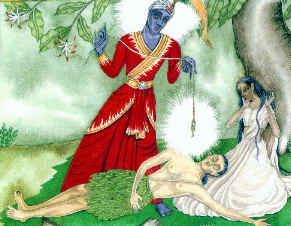 3. Savitri 3. Savitri
She, who is mentioned among the great chaste and
faithful godly women, took Satyavan as her husband knowing fully well
that he would not live long. When only four days of his age were remaining she
undertook a vow to defeat death.
On the fourth day Satyavan died with Yamaraja
( The god of death ) walking away with his vitality. Savitri walked pursuing
Yamaraja. As they were walking one behind the other, on the way there occured a
' question-answer ' between them. Yamaraja was very much impressed by the gentle
behaviour of Savitri, her wisdom, her one pointed devotion ( dedication ) to her
husband. Getting pleased he asked Savitri to ask for boons. Savitri asked for
such boons which helped not only to obtain for her the well-being of both her
father's and her husband's families but Yamaraja had also to return the vitality
of Satyavana. Savitri with the power of her chastity and fidelity protected her
good fortune.
Top of Page
4. Draupadi
Draupadi
was a very impressive and
brilliant and strong personality (character) in Mahabharata.
 The
daughter of Drupada, the king of Panchala (Punjab), came to Hastinapur as a
daughter-in-law of the Kuru-clan on being won by Arjuna, at her Swayamvara, by
piercing with arrow the eye of a moving fish on a high pole, looking into the
fish's image in a cauldron of oil below.
She was never ready to
compromise on either her rights as a daughter-in-law or even on the rights of
the Pandavas and remained ever ready to fight back or avenge high-handedness and
injustice meted out to her and them. Draupadi had absolute faith in Sri Krishna.
She was also dear to Sri Krishna equal to his real sister. Draupadi was put
through much suffering and disgrace in life. The
daughter of Drupada, the king of Panchala (Punjab), came to Hastinapur as a
daughter-in-law of the Kuru-clan on being won by Arjuna, at her Swayamvara, by
piercing with arrow the eye of a moving fish on a high pole, looking into the
fish's image in a cauldron of oil below.
She was never ready to
compromise on either her rights as a daughter-in-law or even on the rights of
the Pandavas and remained ever ready to fight back or avenge high-handedness and
injustice meted out to her and them. Draupadi had absolute faith in Sri Krishna.
She was also dear to Sri Krishna equal to his real sister. Draupadi was put
through much suffering and disgrace in life.
Dussasana tried to remove her
clothes and as such made an attempt to violate her modesty in full view of the
assembly.
 During the days of the banishment to jungle of the
Pandavas,
Jayadratha made an attempt to abduct her and during the period of their dwelling
secretly, Keechaka wanted to outrage her modesty. After the duration of their
stay in the jungle was over, Draupadi, with a
view to fulfill her vow ( promise to herself to tie her untied hair after washing
them with the blood of Dussasana ) and to punish all those who had
disgraced her and perpetrated offence against her, blazed the fire of revenge
burning in her heart into the hearts and minds of Pandayas. The refulgence (glow) of Draupadi's lustrous
prototype of womanhood shall always be a source of inspiration for the women of
India.
During the days of the banishment to jungle of the
Pandavas,
Jayadratha made an attempt to abduct her and during the period of their dwelling
secretly, Keechaka wanted to outrage her modesty. After the duration of their
stay in the jungle was over, Draupadi, with a
view to fulfill her vow ( promise to herself to tie her untied hair after washing
them with the blood of Dussasana ) and to punish all those who had
disgraced her and perpetrated offence against her, blazed the fire of revenge
burning in her heart into the hearts and minds of Pandayas. The refulgence (glow) of Draupadi's lustrous
prototype of womanhood shall always be a source of inspiration for the women of
India.
Top of Page
5. Akka
Mahadevi also known as Akka (elder
sister) Mahadevi. She was a 12th century religious poet, much like Meera. She
devoted her life to the worship of Lord Shiva.
Born in Udutadi, this young Veerashaiva saint
achieved Aikya or Oneness with the Divine within a short twenty years of age.
Her outpourings are contained in over 315 vachanas and in a small text for
advanced sadhakas called Yoganga Trividhi. She came on the scene when the
reformist movement of Veerashaivism had just begun to impact, particularly the
lower rungs of the society, with its remarkable empowerment techniques. Right
from her childhood unlike other young girls she chose the Beautiful Lord, Pure
white as the Jasmine, Chennamallikarjuna, as her playmate.Her friends chose to
play with dolls instead. She was never content in fulfilling the restricted role
of a girl in the house. It was more interesting to hear the glories of the Lord.
The urge to go beyond the average practice of Shaiva sampradaya was compelling.
The limitations placed on women, in the pursuit of spirituality and otherwise,
was unacceptable to her. (source: Akka
Mahadevi).
Top of Page
6.
Mira Bai (1498-c.
1546).
 Drenched
in the color of love to Sri Krishna, Mira was a well known devotee of God in the
47th century Kali Yugabda (calculation of time in terms of cycles of ages —
Yugas) i.e. in the 16th century A.D. Entire Bharat, particularly the area where
Hindi is the language that is spoken and read, has been resounding with the
verses sung by Mira in her love for Krishna. In the case of Mira, the daughter
of Ratna Singh Rathaur, attachment with the devotion to Krishna had touched her
heart even in her early childhood. She was married to the son of Maharana, named
Bhojaraja, but her heart and mind were already in the grip of her devotion to
Krishna. Drenched
in the color of love to Sri Krishna, Mira was a well known devotee of God in the
47th century Kali Yugabda (calculation of time in terms of cycles of ages —
Yugas) i.e. in the 16th century A.D. Entire Bharat, particularly the area where
Hindi is the language that is spoken and read, has been resounding with the
verses sung by Mira in her love for Krishna. In the case of Mira, the daughter
of Ratna Singh Rathaur, attachment with the devotion to Krishna had touched her
heart even in her early childhood. She was married to the son of Maharana, named
Bhojaraja, but her heart and mind were already in the grip of her devotion to
Krishna.
She used to be always
absorbed (engrossed) in devotion to God. In the midst of saints, in temples,
she sang her own devotional compositions ( songs ) and danced filled
with emotion. After the untimely death of Bhojaraja, his brother Vikramajit
wanted Mira to turn her back to the path of devotion and face towards the life
of ordinary people. Her going to temples, singing and dancing there, appeared to
him to be against tradition and discipline of his family. For not renouncing her
obstinacy of love to Krishna Mira was subjected to great deal of infliction of.
pain and suffering. But Mira on the contrary, laughingly submitted herself to
these inflictions and bore them with fortitude but there did not occur any
change in the one pointed ness of her divine love and devotion. The refrain of
her life's song was : ' Mine is the preserver of cows who upholds mountain and
no one else '. Her songs in the propensity of emotions are unmatched.
Top of Page
7.
Durgavati
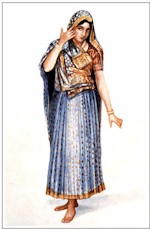 Durgavati
was that brave woman of India during the 47th century of Kaliyugas i.e. 16th
century A.D. who fought with the alien invaders with utmost courage and heroic
bravery and in the end, thinking that lest her living body may even be unpurified
by a touch of the aliens she with her own sword brought forth a
situation of self-sacrificing through which she got the ' going of the brave (
Viragati ) '. Durgavati
was that brave woman of India during the 47th century of Kaliyugas i.e. 16th
century A.D. who fought with the alien invaders with utmost courage and heroic
bravery and in the end, thinking that lest her living body may even be unpurified
by a touch of the aliens she with her own sword brought forth a
situation of self-sacrificing through which she got the ' going of the brave (
Viragati ) '.
After the death of king
Dalpatishah of Gadha Mandala there came the hazard of a crisis over the state.
The Mughal ruler Akbar sent a big army to capture the state of Gadha ( fort )
Mandala. Mounting on an elephant, Maharani Durgavati fought with utmost bravery
along with providing a constant encouragement and inspiration to her army.
Unfortunately because of internal disunity and her army being too small in
comparison with the invaders, self-defense did not succeed. Among the brave
women who resisted, retaliated and acted towards containing the Mughal thirst
for empire-building Maharani Durgavati occupies a high place.
Top of Page
8. Ahilya
Bai Holkar
 After
the death of Malhar Rao Holkar (1694-1766), founder of the Holkar dynasty, as
his son had died before him (killed by a cannon ball), he was succeeded by his
daughter-in-law Ahilya Bai Holkar. She ruled
from 1767 to 1795 with great skill and understanding. She governed the state
from a palace fort at Maheshwar on the northern bank of the Narmada river. After
the death of Malhar Rao Holkar (1694-1766), founder of the Holkar dynasty, as
his son had died before him (killed by a cannon ball), he was succeeded by his
daughter-in-law Ahilya Bai Holkar. She ruled
from 1767 to 1795 with great skill and understanding. She governed the state
from a palace fort at Maheshwar on the northern bank of the Narmada river.
Sir John Malcolm, in his memoirs of Central India described her as
a
"female without vanity...
excercising in the more active and able manner, despotic power with sweet
humanity..."
Though Ahilyabai never stayed in Indore, it is in
her reign that Indore grew up into a city. Indore was an island of prosperity in
a sea of voilence. Her rule became proverbial for justice and wisdom. She was
the rare Indian royalty to be deified in her life time. She contributed a lot to
the heritage of India by establishing several religious edifices remarkable in
architecture. The Kashi Vishweswar temple at Varanasi being notable among
them. Her unique pan-indian look is reflected in the fact that she built Dharmashalas
at Badrinath in the north and Rameshwaram in the south, established Anna
Chhatras at Dwarka in the west, Jagannathpuri in the east, and at
Omkareshwar and Ujjain in central India. She also establishes charitable
institutions at Gaya, Varanasi, Ayodhya, Prayag (Allahabad), Haridwar and
Pandharpur. She was at heart a queen of whole India rather than that of the
Holkar kingdom. She died at Maheshwar where a large mousoleum stands in her
memory.
(source: http://www.ee.ualberta.ca/~naik/holkar.html).
Top of Page
9.
Kittur Rani Chennamma (1778 -
1829)
Chennamma received training in horse riding , sword fighting and archery in her
young age. She was married to Raja Mullasarja of Kittur, a princely state of
Belgaum in Karnataka. Her husband died in 1816. Her only son died in 1824.
Chennamma adopted Shivalingappa as her son and made him heir to the throne. The
British did not accept this and ordered the expulsion of Shivalingappa. The Rani
defied the order. A great battle ensued. The Rani fought the British with great
courage and skill. She could not, however, hold out for long. She was taken
captive and lodged in Bailhongal Fort where she died on 21-02-1829.
(source: Great
Women of India).
Top of Page
10. Queen of
Jhansi - Lakshmi Bai (1830
-1858)
Lakshmi Bai, the Rani of a principality called Jhansi in
northern India, led an uprising against a takeover of her homeland by the
British. She became a heroine and a symbol of resistance to the British rule.
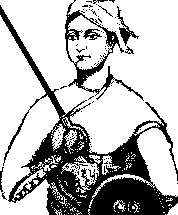 Lakshmi Bai was born around 1830 into a wealthy,
high-caste Brahmin family.
She was named Manukarnika, which is one of the names of the
holy river Ganges. As a young woman, she learned to read, write and debate. She
also learned to ride horses and use weapons while playing with her adopted
brothers. She accepted the name Lakshmi Bai when she married Gangadhar
Rao, the
maharajah of Jhansi and became the Rani (short for maharani, the wife of
maharajah) of Jhansi. Lakshmi Bai was born around 1830 into a wealthy,
high-caste Brahmin family.
She was named Manukarnika, which is one of the names of the
holy river Ganges. As a young woman, she learned to read, write and debate. She
also learned to ride horses and use weapons while playing with her adopted
brothers. She accepted the name Lakshmi Bai when she married Gangadhar
Rao, the
maharajah of Jhansi and became the Rani (short for maharani, the wife of
maharajah) of Jhansi.
Gangadhar Rao was between forty and fifty years of age
at the time of their wedding. This was his second marriage. His first wife died
without producing an heir. The new Rani of Jhansi gave birth to a son, but he
died when he was three months old. Subsequently, Damodar Rao, Gangadhar's
relative, became their adopted son. In 1853, Gangadhar Rao died.
The Governor-General of India, the Marquess of
Dalhousie, announced that since Gangadhar Rao left no heir, the state of Jhansi
would be annexed by the British Government. The British rejected the claim that
Damodar Rao was the legal heir. According to Hindu law, little Damodar Rao was
Gangadhar's heir and successor. In the Hindu religion, a surviving son, either
biological or adopted, had an obligation to perform certain sacrifices after his
father's death to prevent his father from being condemned to punishment or hell.
The refusal of the British to acknowledge the legitimacy of Rajah's adopted son
caused a serious consternation in the local population. Rani appealed her case
to London, but that appeal was turned down.
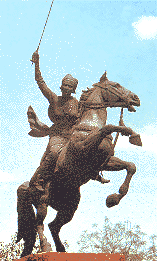 Not wishing to give up her kingdom, Lakshmi Bai
assembled a volunteer army of 14,000 rebels and ordered that defenses of the
city itself be strengthened. Jhansi was attacked by the British in March 1858.
Shelling of Jhansi was fierce and the British were determined not to allow any
rebels to escape while Rani was determined not to surrender. The British noted
that the Indian soldiers fighting them showed more vigor than they ever had
while following British orders. Women were also seen working the batteries and
carrying ammunition, food and water to the soldiers. Rani, herself, was seen
constantly active in the defense of the city. Jhansi, however, fell to the
British forces after a two week siege. A priest from Bombay who witnessed the
British victory, said that what followed were four days of fire, pillage, murder
and looting without distinction. He said it was difficult to breathe due to
strong smell of burning flesh. British historians, on the other hand, suggested
that while four to five thousand people died in battle, the civilians were
spared. Not wishing to give up her kingdom, Lakshmi Bai
assembled a volunteer army of 14,000 rebels and ordered that defenses of the
city itself be strengthened. Jhansi was attacked by the British in March 1858.
Shelling of Jhansi was fierce and the British were determined not to allow any
rebels to escape while Rani was determined not to surrender. The British noted
that the Indian soldiers fighting them showed more vigor than they ever had
while following British orders. Women were also seen working the batteries and
carrying ammunition, food and water to the soldiers. Rani, herself, was seen
constantly active in the defense of the city. Jhansi, however, fell to the
British forces after a two week siege. A priest from Bombay who witnessed the
British victory, said that what followed were four days of fire, pillage, murder
and looting without distinction. He said it was difficult to breathe due to
strong smell of burning flesh. British historians, on the other hand, suggested
that while four to five thousand people died in battle, the civilians were
spared.
The Rani managed to escape on horseback under the cover
of darkness and within twenty-four hours rode over one hundred miles to the
fortress of Kalpi. Several other Indian rulers joined the rebel forces there. It
is believed that the Rani was influential in convincing the others to go on the
offensive and seize the fortress of Gwalior. This maneuver was successful and
helped rally the rebel forces together.
It wasn't long, however, before the British forces
determined to win Gwalior back. A fierce battle ensued. Rani was in charge of
the eastern side of defense, however she lost her life on the second day of
fighting. The British won back Gwalior. Rani's body was given a ceremonial
cremation and burial by the faithful servants. Sir Hugh Rose, the commander of
the British force, wrote later, "The Ranee was remarkable for her bravery,
cleverness and perseverance; her generosity to her Subordinates was unbounded.
These qualities, combined with her rank, rendered her the most dangerous of all
the rebel leaders." A popular Indian ballad said:
How valiantly like a man fought she,
The Rani of Jhansi
On every parapet a gun she set
Raining fire of hell,
How well like a man fought the Rani of Jhansi
How valiantly and well!
"Bundeli har boli mein suni yehi kahani thi...
Khoob laDi mardaani woh toh Jhansi Wali Rani thi...."
(for more information refer to site
on Jhansi
Ki Rani).
J. Lang, who was the only Britisher who saw her
face to face, left the following description of her: "She was a woman of
about the middle size, rather stout but not too stout. Her face must have been
very handsome when she was younger, and even now it had many charms... The
expression also was very good and very intelligent. The eyes were particularly
fine and the nose very delicately shaped... Her dress was a plain white muslin,
so fine in texture and drawn about her in such a way and so tightly that the
outline of her figure was plainly discernible, and a remarkably fine figure she
had."
 "Bundelay harbolon ke munh hamne suni kahani
thi/khuh lari mardani woh
to Jhansi wali Rain thi" sings the ballad narrating the valiant struggle of
one of the most famous characters of India in recent history. When Rani Lakshmi
Bai rose against the British in I857 AD she immortalized Jhansi. She has since
become a heroine of the Indian independence movement, a sort of central Indian
Joan of Arc. "Bundelay harbolon ke munh hamne suni kahani
thi/khuh lari mardani woh
to Jhansi wali Rain thi" sings the ballad narrating the valiant struggle of
one of the most famous characters of India in recent history. When Rani Lakshmi
Bai rose against the British in I857 AD she immortalized Jhansi. She has since
become a heroine of the Indian independence movement, a sort of central Indian
Joan of Arc.
Long before Bal
Gangadhar Tilak said "Swaraj hamara janm huk hai," Jhansi Lakshmi Bai
said "Azadshahi hamara huk hai."
References:
1. The Warrior Queens. The Legends and the Lives of the Women Who Have Led
Their Nations in War - By Antonia Fraser, Vintage Books, 1994.
2. Herstory - Women Who Changed the World -
edited by Ruth Ashby and
Deborah Gore Ohrn, Viking, 1995.
For more refer to chapter on GlilmpsesVIII).
Top of Page
11. Rani
Avantibai
When Vikramaditya Singh, the ruler of Ramgarh State died leaving behind his wife
Avantibai and no heir to the throne, the British put the state under court
administration. Avantibai vowed to win back her land from the British. She
raised an army of four thousand men and led it herself against the British in
1857. A fierce battle ensured and Avantibai fought most valiantly but could not
hold out for long against the superior strength of the British army. When her
defeat become imminent she killed herself with her own sword and became a martyr
on 20-03-1858.
(source: Great
Women of India)
Top of Page
12 Jalkari
Bai
The folklore of Bundelkhand (part of
Jhansi State then ) are full of heroic exploits of Jalkari Bai. She was a
village girl and hailed from a very poor family. It is said that she had an
encounter with a tiger while she was collecting firewood in the jungle and she
killed the tiger single handed with her axe. She had a striking resemblance to
Rani Laxmibai of Jhansi and because of this Rani took interest in her and
inducted her into the women's wing of the army.
During 1957-58 there were several British raids on Jhansi Fort and the Rani
repulsed every one of the attacks. Later when the fall of fort became imminent
Jalkari bai and some generates convinced Laxmibai to escape quietly with the
help of supporters. In a ploy to deceive the British, Jalkari bai dressed
herself up like the Rani and took command of the army. The British found out the
truth, but it was too late. The Rani had covered a considerable distance by
then. Jalkaribai fought the British forces valiantly but was eventually forced
to surrender. The British general, impressed by her loyalty, courage and
fighting prowess treated her with respect and set her free.
(source: Great
Women of India)
Top of Page
13. Shakuntala Devi  Shakuntala
Devi, the human computer - holds an undisputed place in the Guinness Book of
Records for multiplying in 1980 two randomly chosen 13-digit numbers and giving
the correct answer in 28 seconds.
Shakuntala
Devi, the human computer - holds an undisputed place in the Guinness Book of
Records for multiplying in 1980 two randomly chosen 13-digit numbers and giving
the correct answer in 28 seconds.
Her abilities, defying common theories of
human intelligence, have been the subject of much research. In 1977 she won a
standing ovation from an audience of mathematicians when she extracted the 23rd
root of a 201-digit number. That means she found the number that when multiplied
by itself 23 times equaled the 201-digit number she was given. She solved it in
50 seconds flat. The day's most sophisticated computer, a Univac 1108, also did
the deed - in 62 seconds - but only after days of programming, 13 thousand
instructions and 5,000 data locations. No one has a plausible theory as to how
she could have arrived at the answer, for the feat far exceeds the supposed
limits of human intelligence. Shakuntala
Devi attributes her mathematical wizardry to her friendship with Lord Ganesha,
developed in her early childhood.
Top of Page
14. Sarojini
Naidu 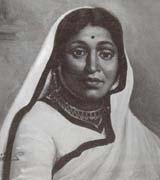 Sarojini
Naidu, (1879-a freedom fighter and the first Indian woman as Governor of West
Bengal after the partition. Sarojini Naidu was a poet, mother of four and the
first President of the Indian National Congress. Widely known as the Nightingale
of India, she was the younger sister of the renowned poet, actor and playwright,
Harindranath Chattopadhyaya. Sarojinidevi was a great patriot, politician,
orator and administrator. She had an integrated personality and could mesmerize
audiences with her pure honesty and patriotism. She was a life-long freedom
fighter, social worker, ideal housewife and poet. Sarojini
Naidu, (1879-a freedom fighter and the first Indian woman as Governor of West
Bengal after the partition. Sarojini Naidu was a poet, mother of four and the
first President of the Indian National Congress. Widely known as the Nightingale
of India, she was the younger sister of the renowned poet, actor and playwright,
Harindranath Chattopadhyaya. Sarojinidevi was a great patriot, politician,
orator and administrator. She had an integrated personality and could mesmerize
audiences with her pure honesty and patriotism. She was a life-long freedom
fighter, social worker, ideal housewife and poet.
She was born on February 13, 1879 in Hyderabad. Her
father, Dr. Aghornath Chattopadhyaya, was the founder of Nizam College of
Hyderabad and a scientist. Her mother, Mrs. Varasundari, was a Bengali poetess.
Sarojinidevi inherited qualities from both her father and mother.
Young Sarojini was a very bright and proud girl. Her
father aspired for her to become a mathematician or scientist, but she loved
poetry from a very early age. Once she was working on an algebra problem, and
when she couldn't find the solution she decided to take a break, and in the same
book she wrote her first inspired poetry. She got so enthused by this that she
wrote "The Lady of the Lake", a poem 1300 lines long. When her father
saw that she was more interested in poetry than mathematics or science, he
decided to encourage her. With her father's support, she wrote the play
"Maher Muneer" in the Persian language. Dr. Chattopadhyaya distributed
some copies among his friends and sent one copy to the Nawab of Hyderabad.
Reading a beautiful play written by a young girl, the Nizam was very impressed.
The college gave her a scholarship to study abroad. At the age of 16 she got
admitted to King's College of England. There she met famous laureates of the
time.
During her stay in England, Sarojini met Dr. Govind
Naidu from southern India. After finishing her studies at the age of 19, she got
married to him during the time when inter-caste marriages were not allowed. Her
father was a progressive thinking person, and he did not care what others said.
Her marriage was a very happy one.
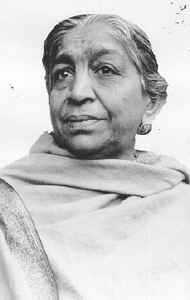 Her
major contribution was also in the field of poetry. Her poetry had beautiful
words that could also be sung. Soon she got recognition as the "Bul Bule
Hind" when her collection of poems was published in 1905 under the title
"Golden Threshold". After that, she published two other collections of
poems--"The Bird of Time" and "The Broken Wings". In 1918,
" Feast of Youth" was published. Later, "The Magic Tree",
"The Wizard Mask" and "A Treasury of Poems" were published.
Mahashree Arvind, Rabindranath Tagore and Jawaharlal Nehru were among the
thousands of admirers of her work. Her poems had English words, but an Indian
soul. Her
major contribution was also in the field of poetry. Her poetry had beautiful
words that could also be sung. Soon she got recognition as the "Bul Bule
Hind" when her collection of poems was published in 1905 under the title
"Golden Threshold". After that, she published two other collections of
poems--"The Bird of Time" and "The Broken Wings". In 1918,
" Feast of Youth" was published. Later, "The Magic Tree",
"The Wizard Mask" and "A Treasury of Poems" were published.
Mahashree Arvind, Rabindranath Tagore and Jawaharlal Nehru were among the
thousands of admirers of her work. Her poems had English words, but an Indian
soul.
One day she met Shree Gopal Krishna Gokhale. He said to
her to use her poetry and her beautiful words to rejuvenate the spirit of
Independence in the hearts of villagers. He asked her to use her talent to free
Mother India.
Then in 1916, she met Mahatma Gandhi, and she totally
directed her energy to the fight for freedom. She would roam around the country
like a general of the army and pour enthusiasm among the hearts of Indians. The
independence of India became the heart and soul of her work.
She was responsible for awakening the women of India.
She brought them out of the kitchen. She traveled from state to state, city
after city and asked for the rights of the women. She re-established self-esteem
within the women of India.
(source: http://swaraj.net/iffw/profiles/naidu_s.htm).
Top of Page
15. Sarada Devi
Sri Sarada Devi was born in Bengal in 1853 to devout
Brahmin parents. Her early years were marked by simplicity, charity, prayer,
meditation and visionary gifts. At the age of six, she was betrothed to Sri
Ramakrishna, but they lived apart until Sarada Devi was 18. It was he who
initiated her into many spiritual disciplines, notably into the worship of the
Divine Mother. Living a celibate life, they saw God in themselves and in each
other. Sri Ramakrishna taught her the great mantras and instructed her in the
method of spiritual guidance for others who would seek her help.
Immediately after her husband's death in 1886, Sri
Sarada Devi began a pilgrimage through North India. For a time she lived at
Vrindavan, where she attained the highest contentless consciousness called
nirvikalpa samadhi, and where she began her role as guru.
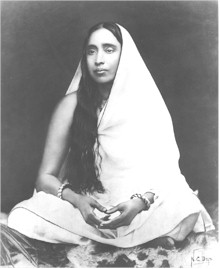 On
her return, Sri Sarada Devi went to Kamarpukur, where she met with great
hostility from the uncomprehending villagers. Having no money and strictly
observing purdah, she was forced to dig the earth herself to cultivate a few
vegetables. When Sri Ramakrishna's disciples heard of her plight, they invited
her to Calcutta. There she became known as the Holy Mother and gave spiritual
instruction and initiation to many people. She was noted for her maternal
tenderness and hospitality, her gift of healing, and her willingness to suffer
vicariously for her disciples' sins. On
her return, Sri Sarada Devi went to Kamarpukur, where she met with great
hostility from the uncomprehending villagers. Having no money and strictly
observing purdah, she was forced to dig the earth herself to cultivate a few
vegetables. When Sri Ramakrishna's disciples heard of her plight, they invited
her to Calcutta. There she became known as the Holy Mother and gave spiritual
instruction and initiation to many people. She was noted for her maternal
tenderness and hospitality, her gift of healing, and her willingness to suffer
vicariously for her disciples' sins.
In 1909, Sri Sarada Devi moved into what is known as
the Holy Mother's House in Calcutta, and lived there for the next 11 years with
several other holy women. In 1919, she was stricken with black fever and,
although in great pain, continued to strengthen her disciples and to give
spiritual advice until her death on July 20, 1920.
The spiritual teachings of this great woman seer are a
window on the beauty of her soul: "As clouds are blown away by the wind,
the thirst for material pleasures will be driven away by the utterance of the
Lord's name." "No one is a stranger, my child; this whole world is
your own."
(source: http://www.hssworld.org/all/great_people/sarada.html)
Top of Page
16. Bhagini Nivedita
- A Proud, Generous, Momentous and Ardent Woman (1867-1911)
She great offering, giving her life for Mother
India, was like a song of love, Love is blind for it sees no faults of the
beloved, and Nivedita never found faults with India. Sister Niveditas childhood
name was Margaret Elizabeth Noble.
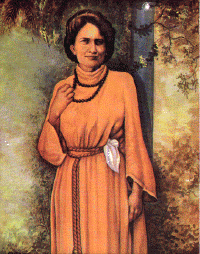 She
was born in Ireland on October 20, 1867 to parents Mary Isabel and Samuel
Richmond Noble Her father was a preacher to whom religion meant service to the
poor. This had an imprint on Nivedita. She was very intelligent and hard worker,
loved music, art, and the natural sciences. After her education, she spent ten
years in teaching, from 1884 to 1894. She had a gift of being able to impart
knowledge and inspire her students She was a proud, generous, impulsive and
ardent woman. By the age eight~eil she came to understand that religion did not
mean belief in the doctrines; it meant search of Divine Light and Eternal Truth.
She began to doubt the truth of the Christian doctrines. She started reading
about Buddhism but only with partial success. She
was born in Ireland on October 20, 1867 to parents Mary Isabel and Samuel
Richmond Noble Her father was a preacher to whom religion meant service to the
poor. This had an imprint on Nivedita. She was very intelligent and hard worker,
loved music, art, and the natural sciences. After her education, she spent ten
years in teaching, from 1884 to 1894. She had a gift of being able to impart
knowledge and inspire her students She was a proud, generous, impulsive and
ardent woman. By the age eight~eil she came to understand that religion did not
mean belief in the doctrines; it meant search of Divine Light and Eternal Truth.
She began to doubt the truth of the Christian doctrines. She started reading
about Buddhism but only with partial success.
This was the time when she met a Hindu Monk,
Swami Vivekanand visiting England in 1895. She attended all the lectures. In
question-answer sessions, she was an active and enthusiastic participan!. The
Swamiji's words that selfishness, ignorance, and greed were the evils which
brought suffering to the world, pierced through her mind and heart and her life
changed for ever. Swami Vivekanand was very much impressed and urged her to help
the women of I,?dia in his plans. In response to the call of Swaini Vivekananda,
Nivedita left England and arrived in Calcutta on January 28, 1898. Swamiji could
envision her future role in the service of Mother India. He initiated her to be
his disciple on March 25, 1898 and gave her name 'Nivedita', meaning one who is
dedicated to God. She started to study Gita and practice meditation. This helped
her to cast off her pride in English culture and became humble. Salvation for
one self and the welfare of the world were two of the ideas she pledged herself
to follow, For this, she lived a simpler pure, and holy life to realize God and
humbly work for the welfare of the people.
By nature, she was optimist but there were
times she felt disheartened in such situations. Swami Vivekananda's words 'Death
for the cause is our goal, not success' inspired her She made India the object
of love and worship When Swami Vivekananda passed away on July 4. 1902, she felt
an added responsibility to India and its people. She realized that political
independence of India is an essential first step towards equality, progress and
justice
She inspired the people in all walks of life
through her lectures and writings She always believed that India could not be
great and powerful unless there was unity. She emphasized this in every possible
way and was never tired of speaking about it. Her hard work and lack of rest was
having an adverse effect on her health She passed away on October 13, 1911.
Top of Page
17. Mother Mirra
(1878-
1973)
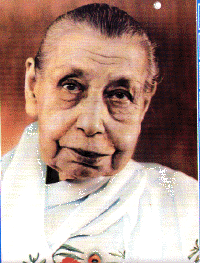 The
Mother, Mirra Alfassa, was born in Paris on the 21st of February 1878. Her
mother was Egyptian and her father was Turkish. Both of them were perfect
materialists. However, Mirra had divine visions from her childhood. The
Mother, Mirra Alfassa, was born in Paris on the 21st of February 1878. Her
mother was Egyptian and her father was Turkish. Both of them were perfect
materialists. However, Mirra had divine visions from her childhood.
Outwardly, she was brought up as an atheist until she
entered adulthood. In her early years, she had a good education in music
(specially piano), painting, and higher mathematics. During this period she used
to have spontaneous experiences including those of coming out of her body to
discover inner realities, without understanding what they really meant. As she
was growing up, she began to have such experiences more often. One day in the
year 1912 the Mother had a first vision of the future: "the advent of
universal harmony, the realization of human unity and the establishment of ideal
society". Sri Aurobindo had already visualized these ideas in his writings.
What a coincidence?
She met Sri Aurobindo on 20th March, 1914. He exactly
resembled the man she used to see in her vision since 1904. She went back to
Paris, Japan and other places and finally returned to Pondicherry in India where
Sri Auribindo had established an Ashram, a celebrated spiritual centre. Now the
question was as to the ways and means by which this great vision of whole-being,
whole-knowledge and whole power could be attained for the whole society. Sri
Aurobindo found, and this was Mother's discovery, that this could be done
through the processes of Yoga, many of which were known, and many of which had
to be rediscovered, created, built and perfected, so that they could meet the
needs of modern man's upward evolution. This was the task Sri Aurobindo was
engaged in since he came to Pondicherry.
The Mother also participated in this endeavor. The
result was what is known as 'Integral Yoga' - developed jointly by Sri Aurobindo
and the Mother. In integral yoga, the Divine Power in us uses all life as the
means of our upward evolution and then every experience becomes a step on the
path to perfection. In this whole process the Mother was Shakti in action. She
accelerated this process with great vigor even after Sri Aurobindo left his
mortal body on December 5, 1950. She continued to expand that vision through
education and counseling of the seekers of inner peace. Under her direction,
Pondicherry developed into a residential Ashram.
Her imprint can be seen in almost all aspects of Ashram
routine. She worked relentlessly till she passed away on November 17, 1973.
(source: http://www.hinduwomen.org/biographies/mother.htm).
For more information please refer to Women
In Hindu Dharma - A Tribute. A brief compilation done by Vishal
Agarwal for the Hindu Students Society of the University of Minnesota.
Top of Page
18. Lalleshwari
(1320 – 1390).
The Hindus called her Lalleshwari and the Muslims Lalla Arifa.
But both endearingly called her Lal DED (Grandmother or Grandma).
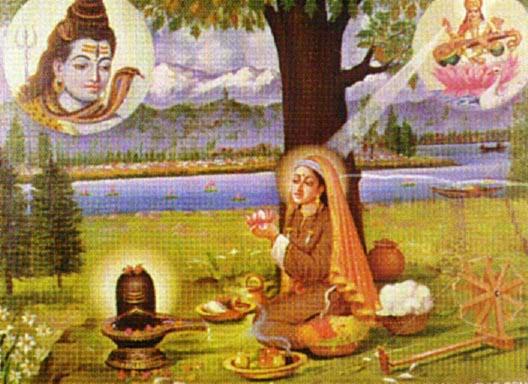
Lalleshwari
was a sadhvini or female wandering devotee of Lord Shiva who was hailed as a
great Siddha or enlightend master of her time.
***
Lalleshwari
was a sadhvini or female wandering devotee of Lord Shiva who was hailed as a
great Siddha or enlightend master of her time. As a poet her poetry is still
influential, especially in Kashmir. She spent life wandering throughout northern
India and renounced the householder life while still very young.
"I lost you out of ignorant attachment to my body. Then
I wasted my time searching high and low. Finally I found you within, O Shiva,
then we united in Bliss. Only though the grace and compassion of Siddhanath
could this have happened."
Lalleshwari
was born into a Brahmin family in Kashmir in the medieval period. Independent by
nature she married early to young man of the same caste. Her husband was
apparently was very much under the influence of his mother and according to
legend the mother hated her daughter-in-law intensely. Not content with acting
maliciously towards Lalli, the mother poisened her son's mind against her and it
has been suggested that this may have been because Lalli never became pregnant.
Finally her mother-in-law turned her out of her house.
Instead
of returning to her family home, Lalli took up the life of a sadhvini or Yogini.
Her philosophy and practices as recorded in her poems show a
deep understanding of the central tenets of the Shaitive non-dual philosophy.
There
is no doubt that Lallishwari commanded and commands great respect among the
Shaiva sects but the great Sufi's of her time also revered her. Among the people
she was given the title Ded (Grandmother), and this reflects the affection and
respect with which the common people regarded her.
(source: Lal
Diddiji - By Vishwanath and Lalleshwari
- By P N Razdan ).
Top of Page
19. Lakshmi
Bai Kelkar
(1905-1978)
Affectionately
called as 'Vandaniya Mausiji'
One
of the crusaders for women's emancipation in India in the 1930s and
who was responsible for starting a mighty organization for
rehabilitation of women in India called 'Rastra Sevika Samiti' was
Smt. Lakshmi Bai Kelkar (1905-1978),
affectionately called as 'Vandaniya Mausiji'.
Vandaniya
Mausiji's
life story is an
inspiring tale, a saga of a great warrior who battled against heavy
odds all her life and finally emerged as a victor. She was a woman
of great mental fortitude and moral courage.
Fortitude
was the marshal of her thought, the armour of her will and the fort
of her reason. Her guiding motto throughout her life can be put in
these words: You gain strength, courage and confidence by every
experience in which you really stop to look fear in the face. You
must do the thing which you think you cannot do. This was the
guiding philosophy of her life.
Mausiji
was born on 6 July 1905 in Nagpur. She was named 'Kamal' i.e. lotus
flower. As a child Kamal was adored by every one. She loved going to
the temples with her auntie popularly known as 'Dai'. The
bhajans, stories, and the Hindu rituals to which Kamal was exposed
at the temples, left an indelible impression on her mind and heart.
She was admitted to 'Mission School' which was the only girl's
school situated near her residence. Kamal noticed that what she was
being taught in school was contrary to what she was taught by her
parents and 'Dai'. Yet she tried to get adjusted for the sake of
learning even in that Missionary School.
Kamal's
father had little to offer in the way of dowry. So she firmly
decided to marry a person who would never ask for dowry. Kamal was
married to Purushottam Rao. She was now called Lakshmi Bai Kelkar.
Purushottam Rao already had two daughters from his first wife who
was dead. Lakshmi treated and cared for these girls and was more
than a mother to them. She herself had six sons.

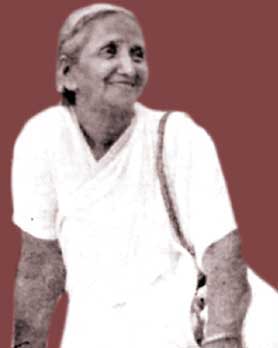
Lakshmi Bai
Kelkar: Affectionately called
as 'Vandaniya Mausiji'
Lakshmi
bai's untiring efforts resulted in laying the foundation of the
first girl's school at Wardha. It later became an established and
known as 'Kesari Mal Girls' School'.
***
In
1932, a great tragedy struck her when her husband Purushottam Rao
died. Shanta, Lakshmi's eldest daughter also died of tuberculosis.
Vatsala, Lakshmi's younger daughter was interested in Education. But
there were no schools at 'Wardha', where she lived then. She
searched for dedicated teachers and arranged their accommodation in
her own house. Her intention was to educate not just her daughter
but numerous other such girls. Thus
Lakshmi's untiring efforts resulted in laying the foundation of the
first girl's school at Wardha. It later became an established and
known as 'Kesari Mal Girls' School'. Venutai Kalamkar and Kalinditai
Patankar were the first teachers of the school who effectively paved
the way for the women's literary movement at Wardha in the 1930s. It
was the starting point of her work in the field of women's
emancipation and development, which later knit the country into a
joint 'Rastra Sevika Samiti' family.
Lakshmi
Bai Kelkar then came to the conclusion that 'it is essential to
create in the heart of every woman, the pride of ancient glorious
Hindu culture'. With the guidance and support from Dr Keshav Baliram
Hedgewar, Sar Sanghachalak of RSS, Lakshmi Bai Kelkar started Rastra
Sevika Samiti, the largest and the only Hindu women's
organization in India. It was started on the auspicious
Vijayadashami day on 25 October 1936. A large number of girls and
ladies gathered under one roof to learn more about Hindutva and
Sanatana Dharma. Every worker in the Samiti was called a Sevika.
Lakshmi Bai who was an affectionate and warm person became a guide,
confidant and role model for all the Sevikas of 'Rastra Sevika
Samiti' throughout India. All the Sevikas began to call her 'Mausiji'
who was like a mother to them. Within a period of four years, she
became the most revered figure, due to her selfless service and
devotion.
Thus
Lakshmi Bai came to be popularly and respectfully addressed as 'Vandaniya
Mausiji'.
(source: A
tireless fighter for Hindu women liberation-I - By V Sundaram -
newstodaynet.com).
Top of Page
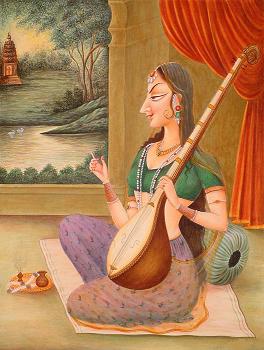 20.
Mirabai (1500 - 1550)
She was born a Rajput princess, is undoubtedly India's best known
saint-poetess of bhakti in the purest Vaishnava tradition. Her
bhakti poetry is immortal. Mirabai was born 500 years ago in a little-known
village called Kurki in Mewar. The much loved daughter of Rana
Ratan Singh, Mira was nurtured by her grandfather Rao Duda in
the fortress city of Merta in Mewar. According to the royal
custom she was married in 1516 to Prince Bhojraj, son of Rana
Sanga, ruler of the Sisodiya clan of Mewar. 20.
Mirabai (1500 - 1550)
She was born a Rajput princess, is undoubtedly India's best known
saint-poetess of bhakti in the purest Vaishnava tradition. Her
bhakti poetry is immortal. Mirabai was born 500 years ago in a little-known
village called Kurki in Mewar. The much loved daughter of Rana
Ratan Singh, Mira was nurtured by her grandfather Rao Duda in
the fortress city of Merta in Mewar. According to the royal
custom she was married in 1516 to Prince Bhojraj, son of Rana
Sanga, ruler of the Sisodiya clan of Mewar.
In 1521 Bhojraj died, soon followed by Rana Sanga.
Mira refused to lead the secluded life of a royal widow and
defied all conventions. She sang and danced with greater mystic
frenzy. Her cymbals and her anklets were heard even in the
temple on the outskirts of the city, a public place open to all
devotees. Such insubordination had never been witnessed before.
The young Rana Vikram and his mother could not treat Mira with
either indifference or clemency. Her rising popularity and
strong political connections made the Rana so jealous that he
tried to kill her several times..
It is said that once a poisonous snake was sent to her in a
flower basket, but when she opened it she found an image of
Krishna; on another occasion she was given a cup of poison but
drank it with Krishna's name on her lips and was miraculously
saved.
This
Rajput princess's lovely songs have inspired many generations of
Hindus. She sang:
"My only Lord is
Giridhar Gopal
None else, none else, in this false world;
I have forsaken my family and friends,
I sit among saintly souls,
I have lost regard for worldly fame and honor,
My heart swells at the sight of the godly,
It shrinks at the sight of the worldly.
I have watered the creeper of God’s love with my own tears.
Churning the curds of life, I have taken out the butter and
thrown away the rest.
The King, my husband, sent me a cup of poison:
I drank it with pleasure.
The news is now public, everyone knows now
That Mirabai has fallen in love with God!
It does not matter now: what was fated to happen, has happened."
Many stories are told of how the devotion of Mirabai for Lord
Krishna led her to abandon her husband, who was the ruler of the
ancient Rajput state of Mewar, and to pass life in complete
dedication to the praise of her God. Once for example, her
husband, hearing her talking in a closed room to a man, rushed
in with drawn sword to kill her for her unfaithfulness. But it
was Krishna with her, and he transformed her into a multitude of
forms so that the king could not tell which one was really his
wife. In response to her continual pleading for a demonstration
of his love for her, Lord Krishna finally revealed himself in his
glory and absorbed her soul into his. Her hauntingly lovely
songs are still popular in western India and Rajasthan. In this
poem, Giridhar Gopal is a name of Krishna.
(source: exoticindiaart.com).
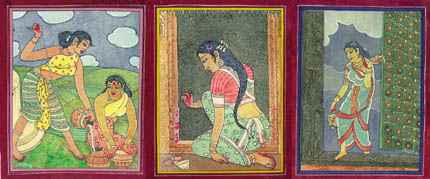
 Did you Know? Did you Know?
Dowry Didn't Evolve from India.
Where'd We Get This Zany Idea?
Hindus got it from the Europeans.
 According to several sources, the present dowry
practice in India can be traced only to the 19th century - likely because that
is when Indians observed the full-fledged practice of dowry among the British
rulers. Here are some excerpts from a wonderfully, enlightening book, The
Marriage Bargain, Women and Dowries in European History. According to several sources, the present dowry
practice in India can be traced only to the 19th century - likely because that
is when Indians observed the full-fledged practice of dowry among the British
rulers. Here are some excerpts from a wonderfully, enlightening book, The
Marriage Bargain, Women and Dowries in European History.
"In France, the dowry was almost a universal
institution, even among servants, laborers and tenant farmers, until the
interwar era (1918-1939). Only the poorest urban industrial workers had no
dowries, and as a result many of them did not marry at all. "For the great
majority of the bourgeoisie (middle class) marriage is the greatest financial
operation of their lives." Wrote an observer of the French scene in
1927.
"What was the status of the daughter whose
birth ' filled a father's heart with fear' (Dante, Renaissance poet, 1265-1321
C. E. because of the large dowry which her marriage would require?"
(source: The
Marriage Bargain, Women and Dowries in European History. By Marion A.
Kaplan. Harrington Park Press. 28 East 22 Street, New York, 100010. USA and Hinduism
Today).
The concept of stri dhan in which gifts
--usually jewelry, including often a quarter pound of gold--was given to the
bride by her family, in order to secure some personal wealth for her when she
married. This jewelry remained her personal property throughout the marriage,
providing some security in case of her husband's death or other calamity. However,
in approximately the 19th century, under the British rule, the loving practice
of stri dhan was joined by the very much different concept of dowry.
Dowry became first an expected, then a demanded, offering given by the bride's
family to the groom's family at the time of marriage. Whereas stri dhan is
considered the property only of the woman, passed matrilineally, dowry is not.
Please refer to a
forthcoming book Dowry
Murder: The Imperial Origins of a Cultural Crime - By Veena Talwar
Oldenburg. The author argues that 'these killings are neither
about dowry nor reflective of an Indian culture or caste system that encourages
violence against women. Rather, such killings can be traced directly to the
influences of the British colonial era. In the pre-colonial period, dowry was an
institution managed by women, for women, to enable them to establish their
status and have recourse in an emergency. As a consequence of the massive
economic and societal upheaval brought on by British rule, womens' entitlements
to the precious resources obtained from land were erased and their control of
the system diminished, ultimately resulting in a devaluing of their very lives.'
More good things thanks to the Christian State.
(source: Taming
the predatory State of today - Rajeev Srinivasan - rediff.com).
The book takes us on a journey into the colonial
Punjab, Veena Oldenburg skillfully follows the paper
trail left by British bureaucrats to indict them for interpreting these crimes
against women as the inherent defects of Hindu caste culture. The British,
Oldenburg claims, publicized their "civilizing mission" and blamed the
caste system in order to cover up the devastation their own agrarian policies
had wrought on the Indian countryside.
(source: amazon.com).
***
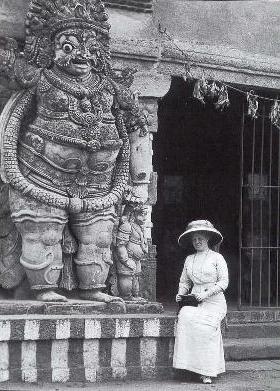
Victorian Prudery?
Indian Temples and 19th
century British woman in India
Indian temples were a popular destination for
British tourist, but escorts usually steered female sightseers away from the
erotic art featured on some temple facades. One 19th century guide book
advised women to tip local guides for not pointing out suggestive temple
carvings.
(source: What
Life Was Like in the Jewel of the Crown: British India AD 1600-1905
- By The Editors of
Time-Life Books.
p.156).
Top of Page




|